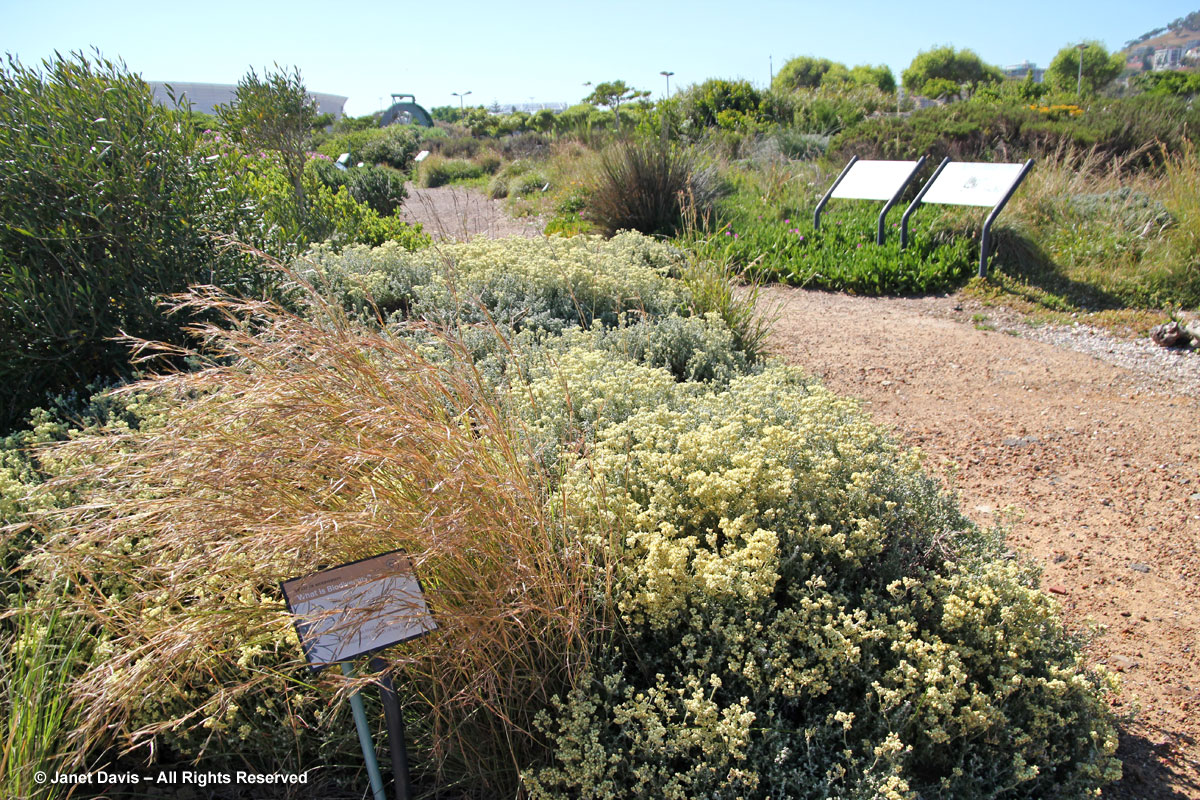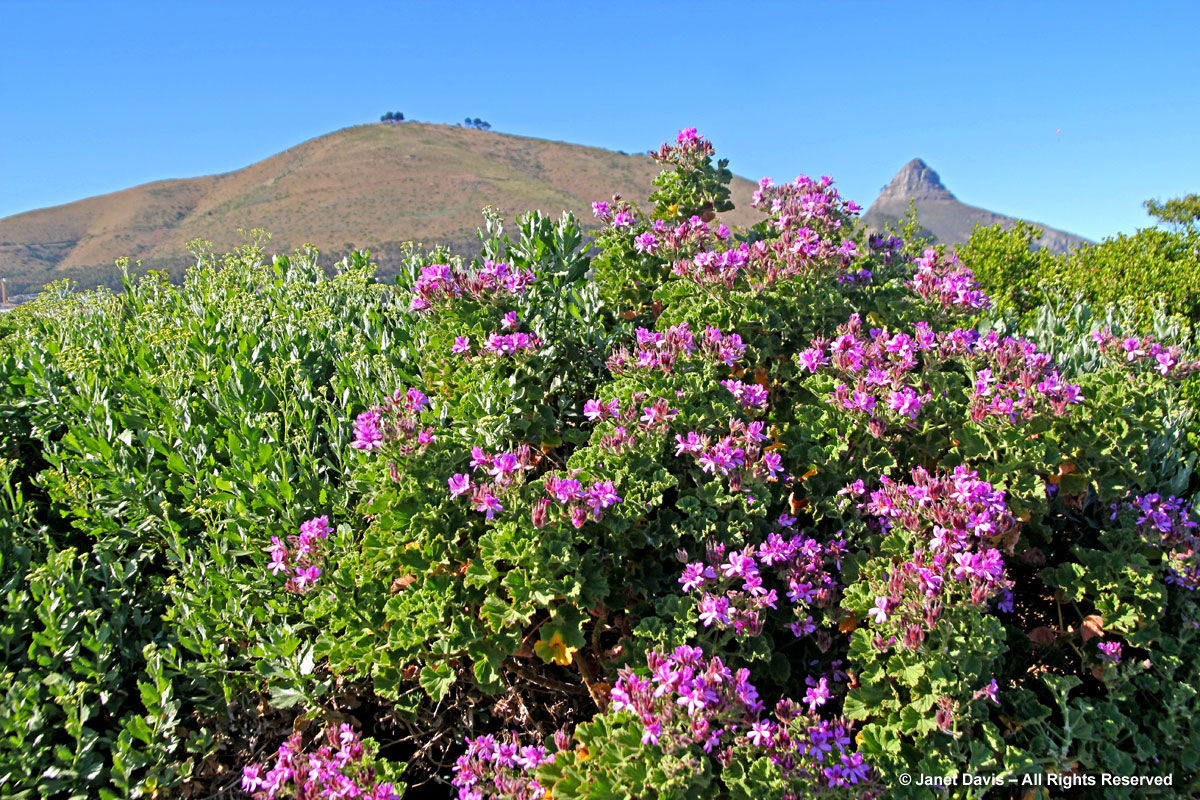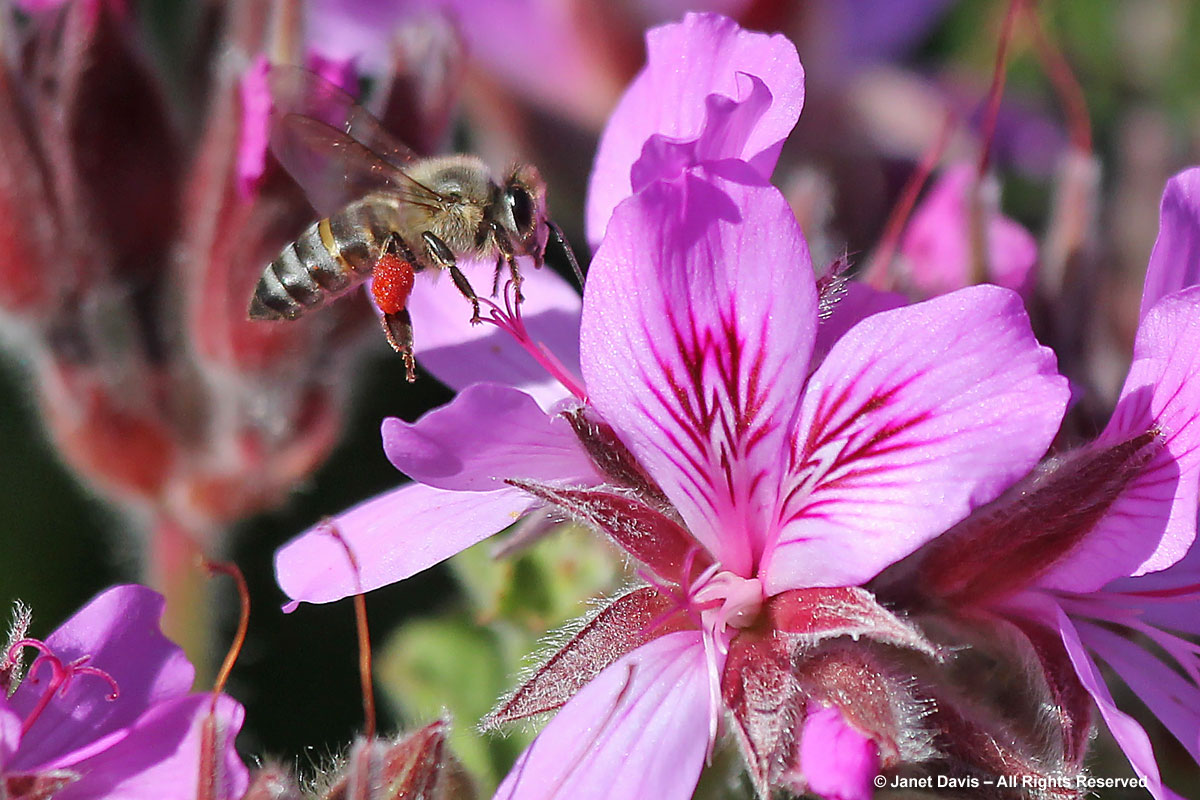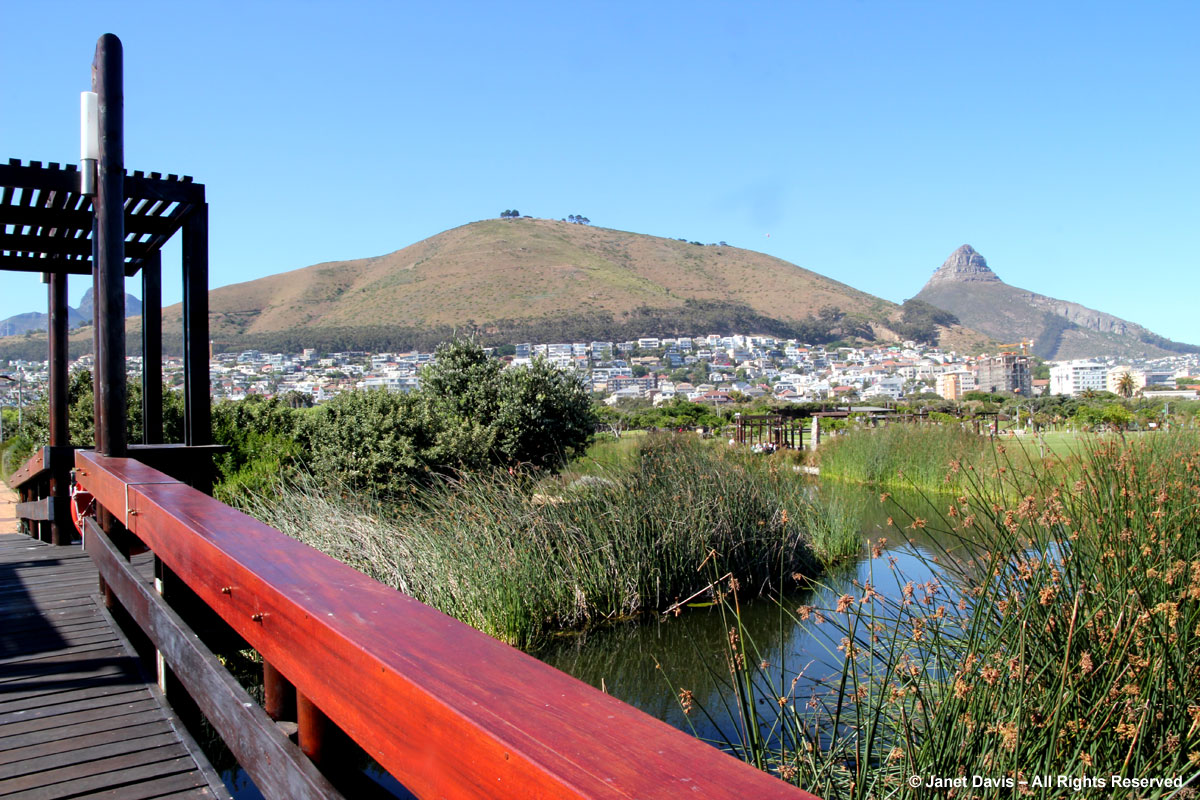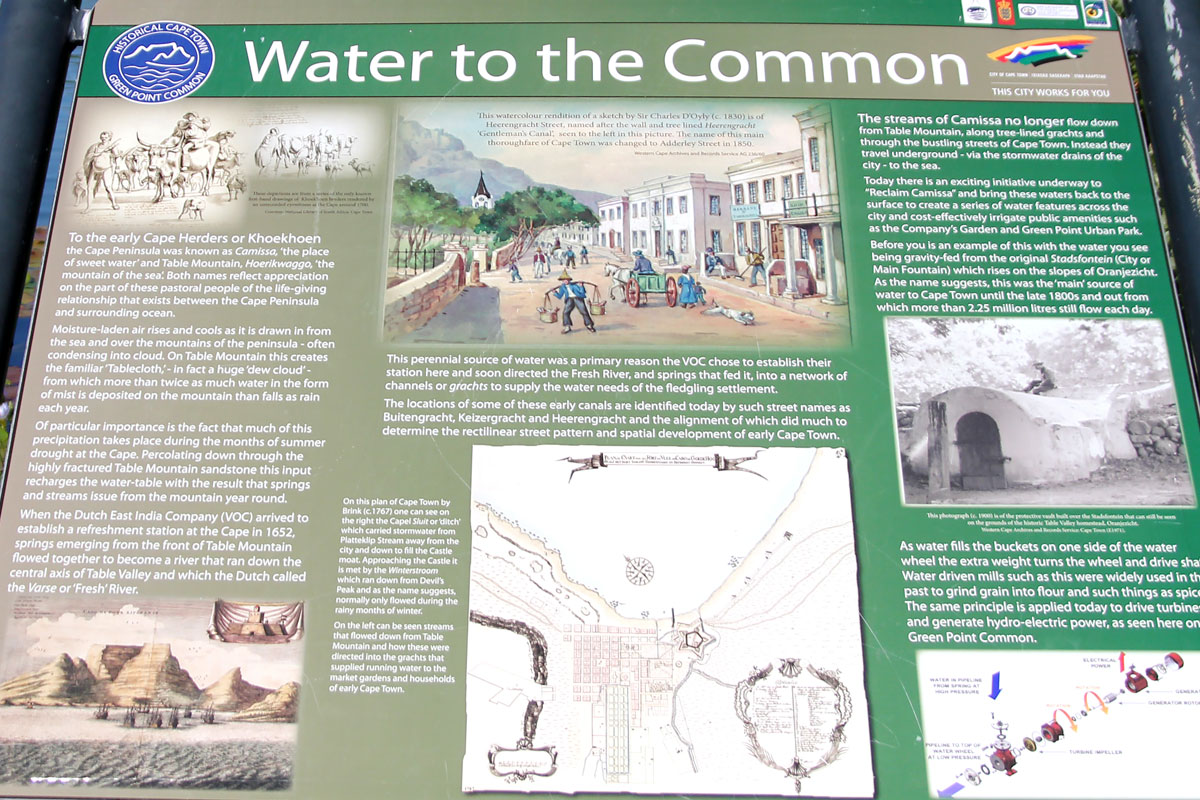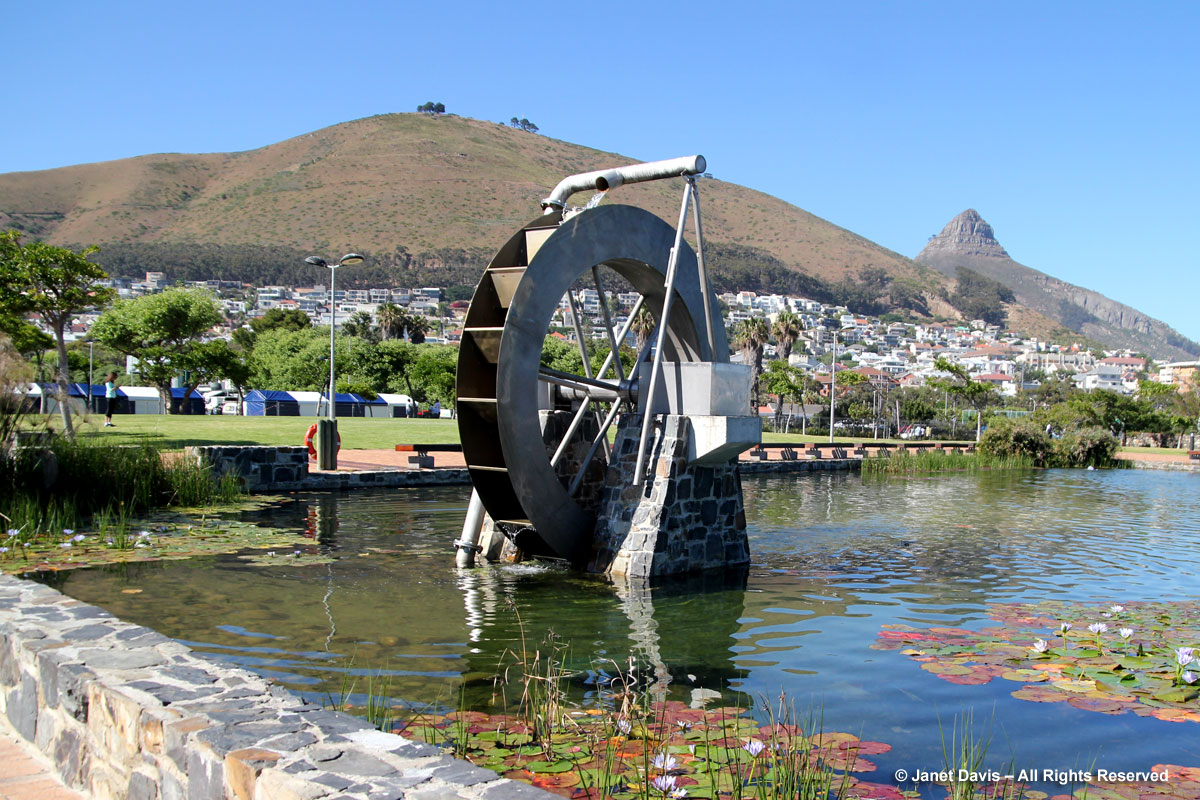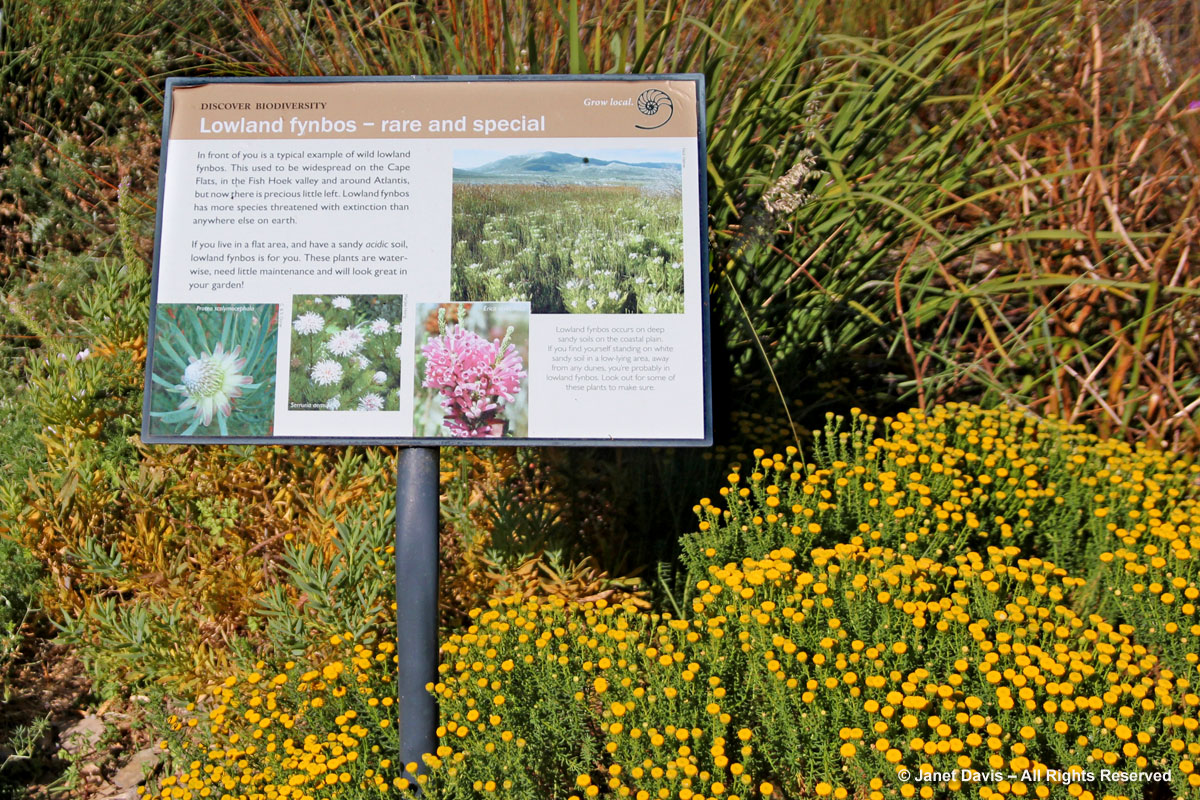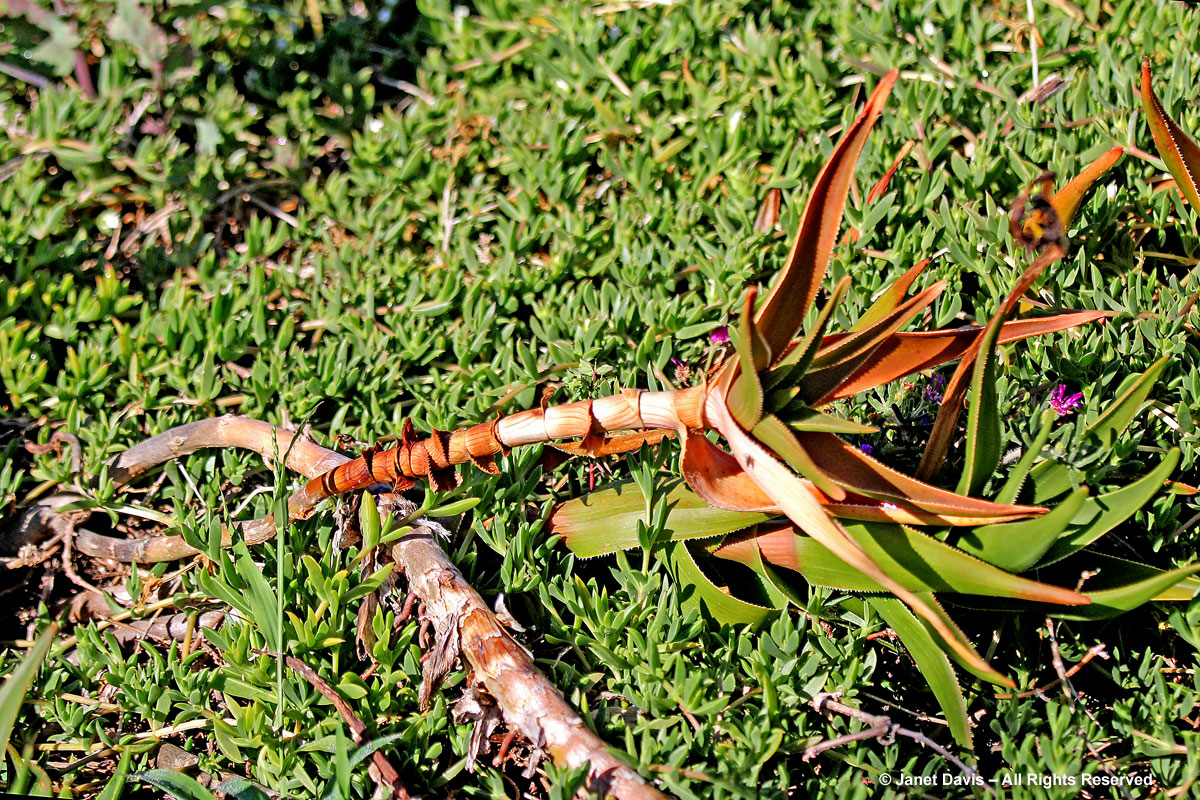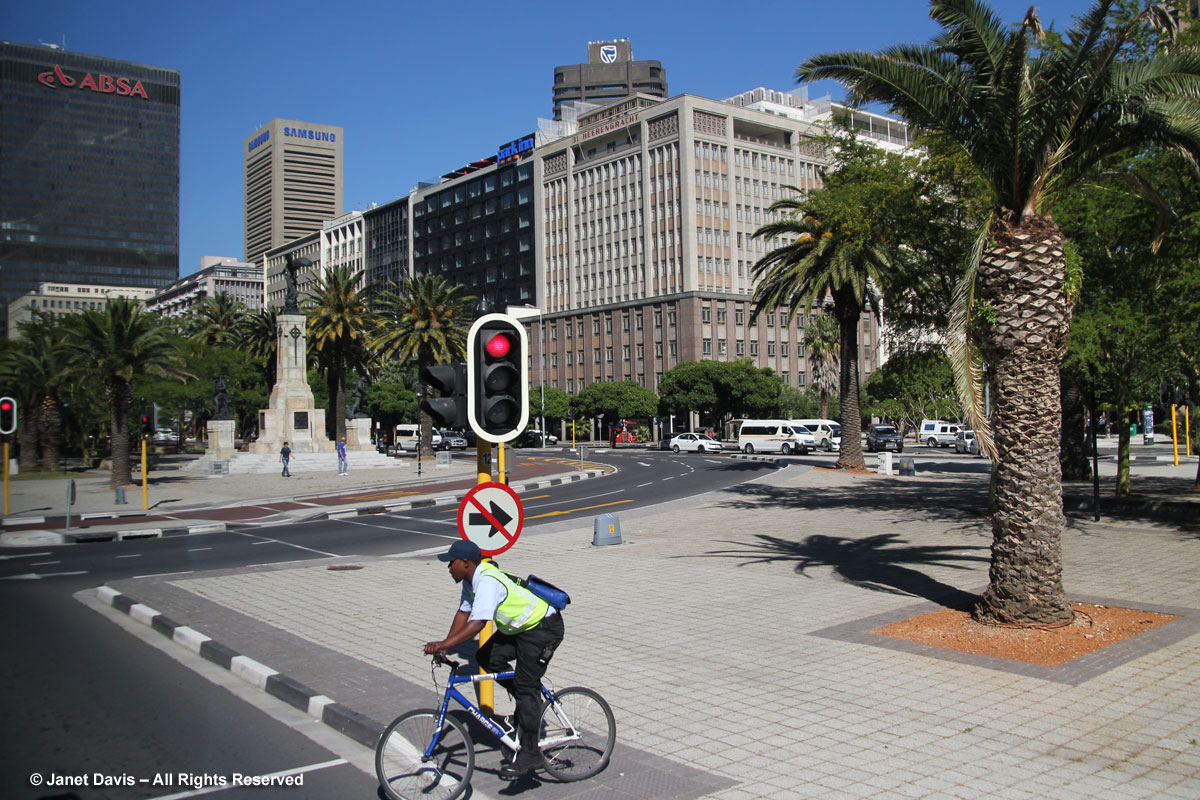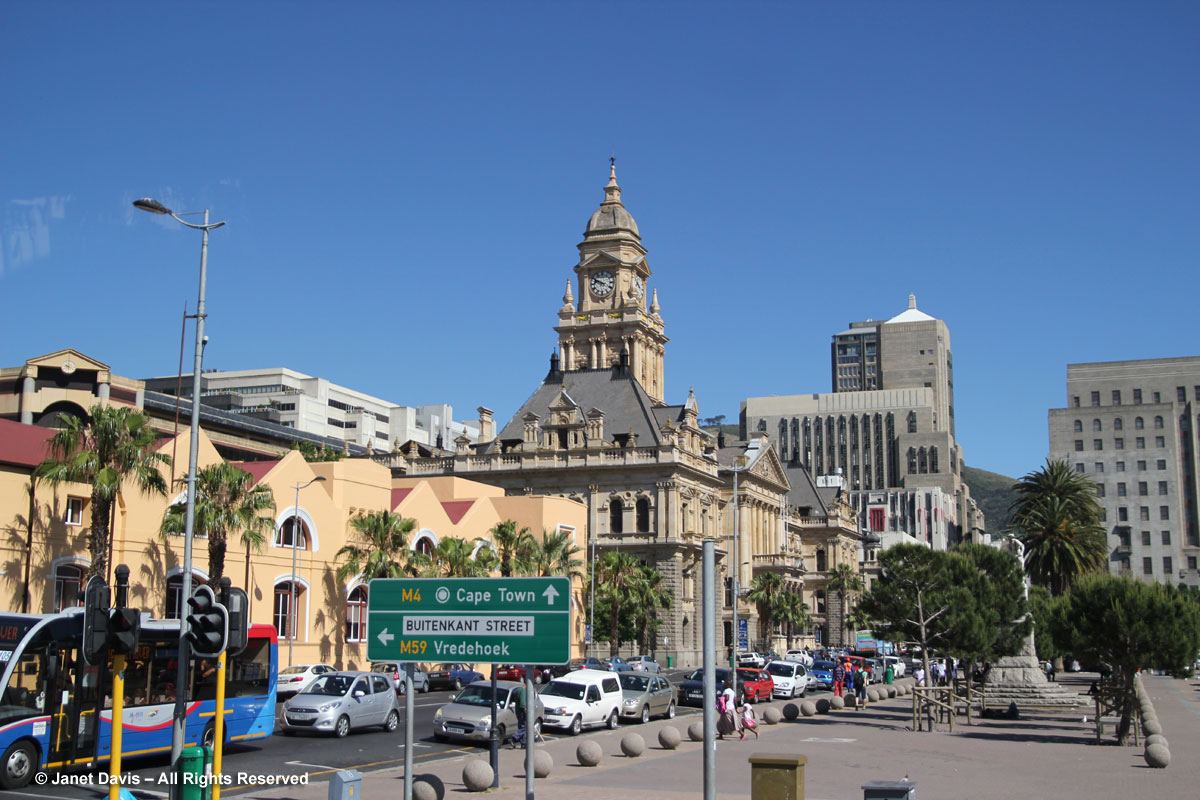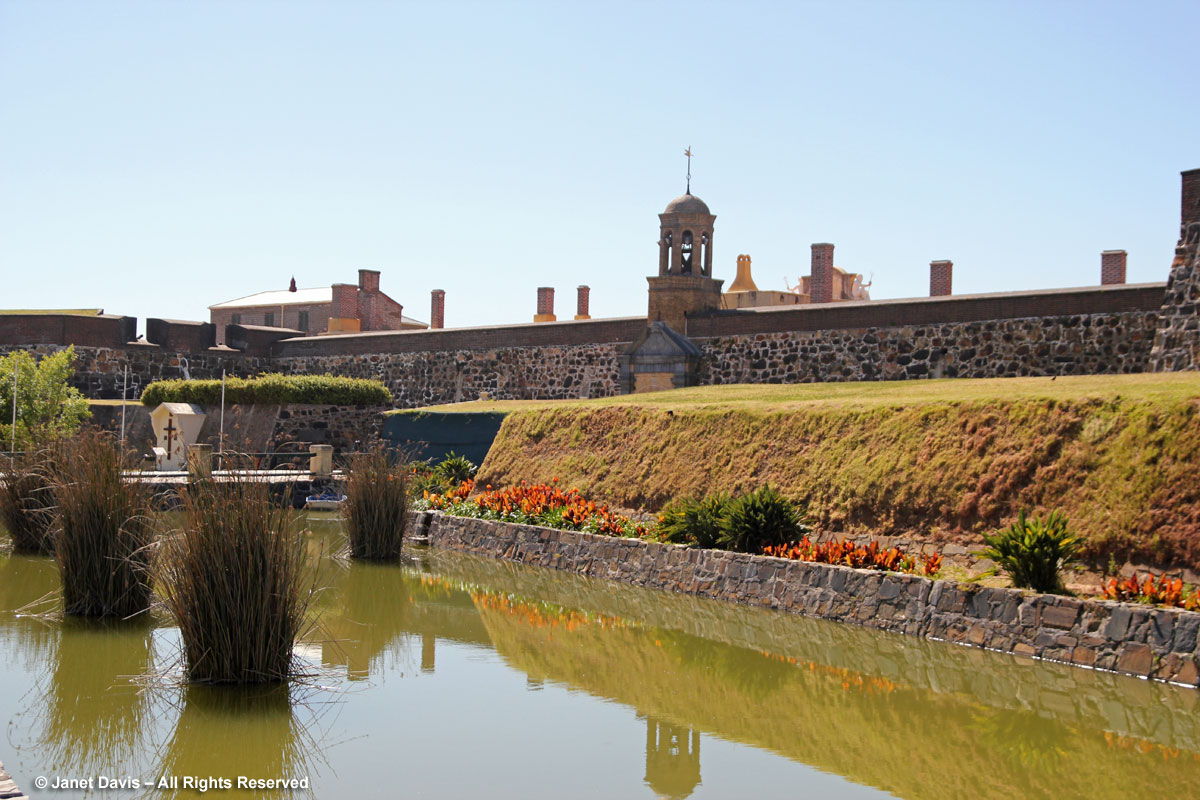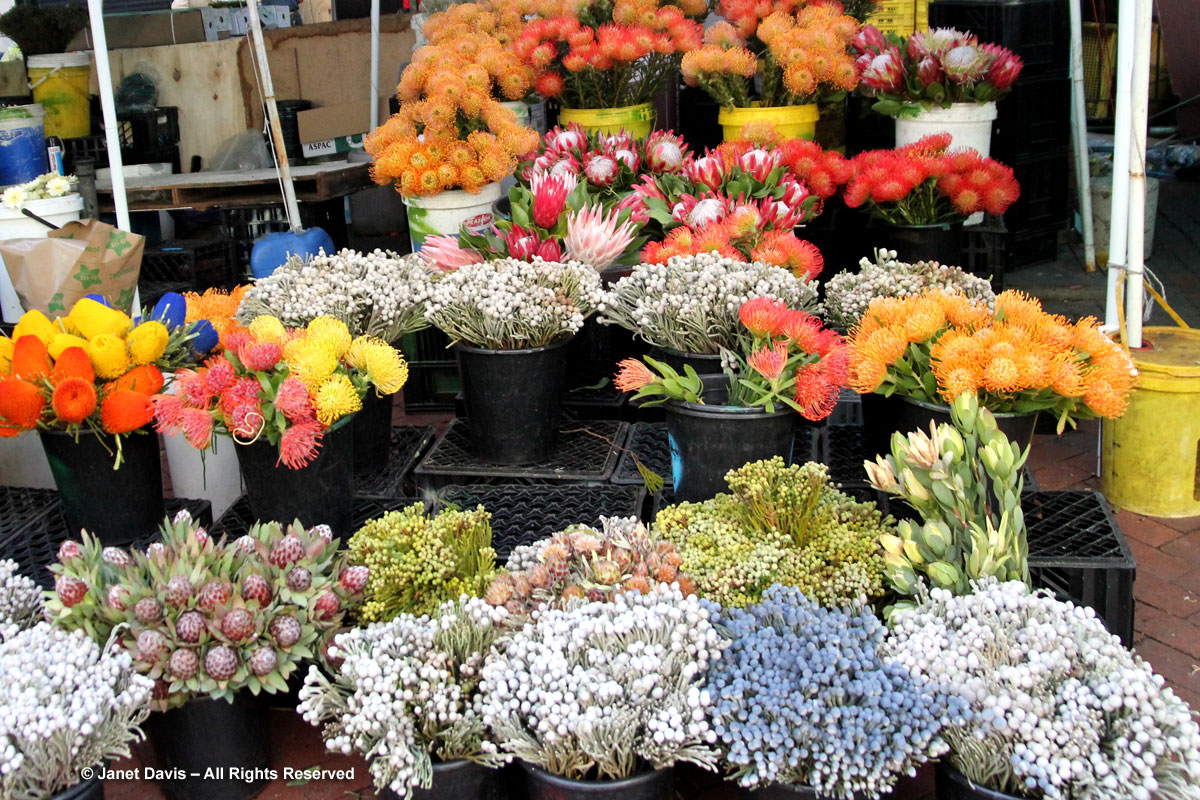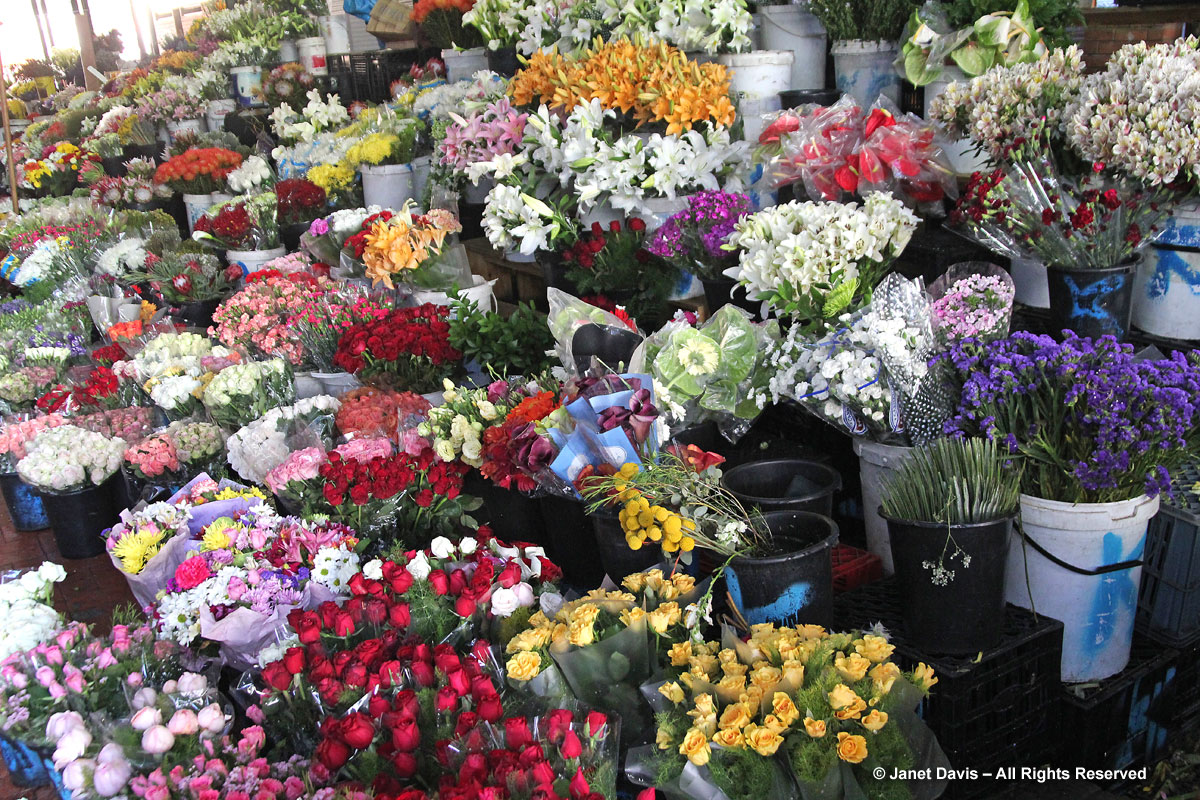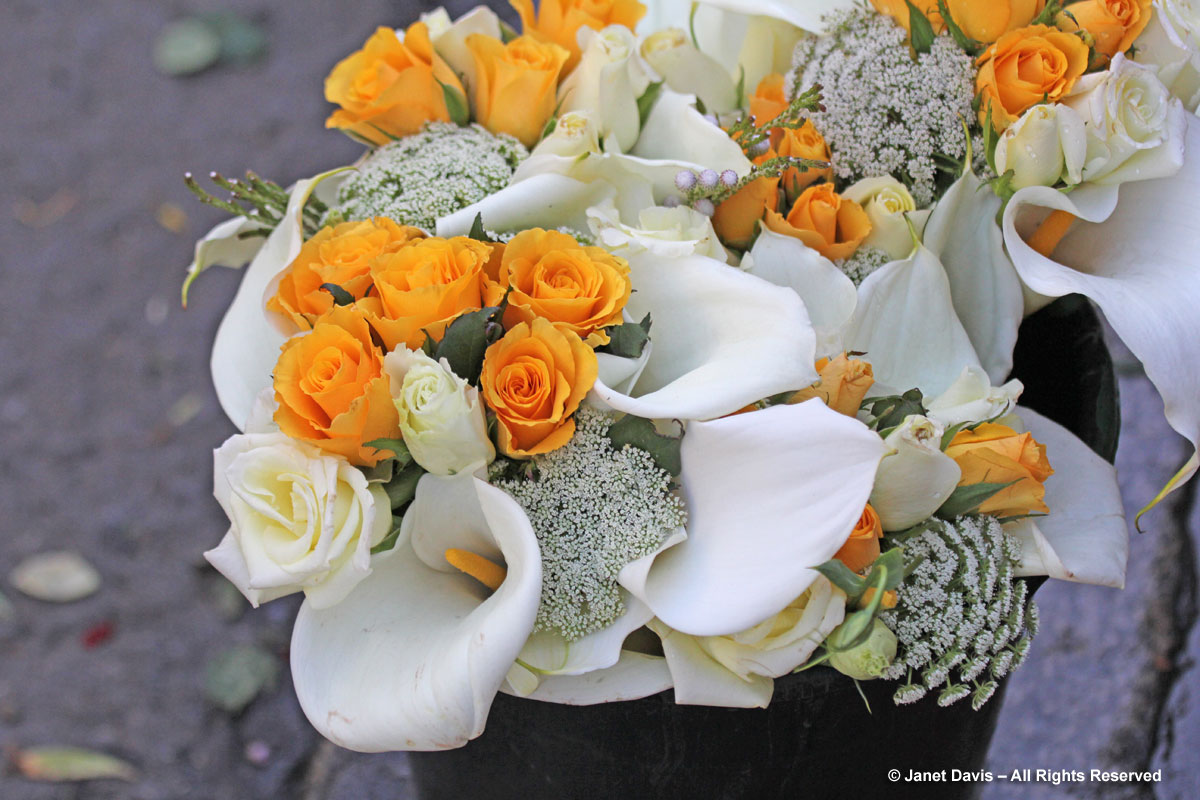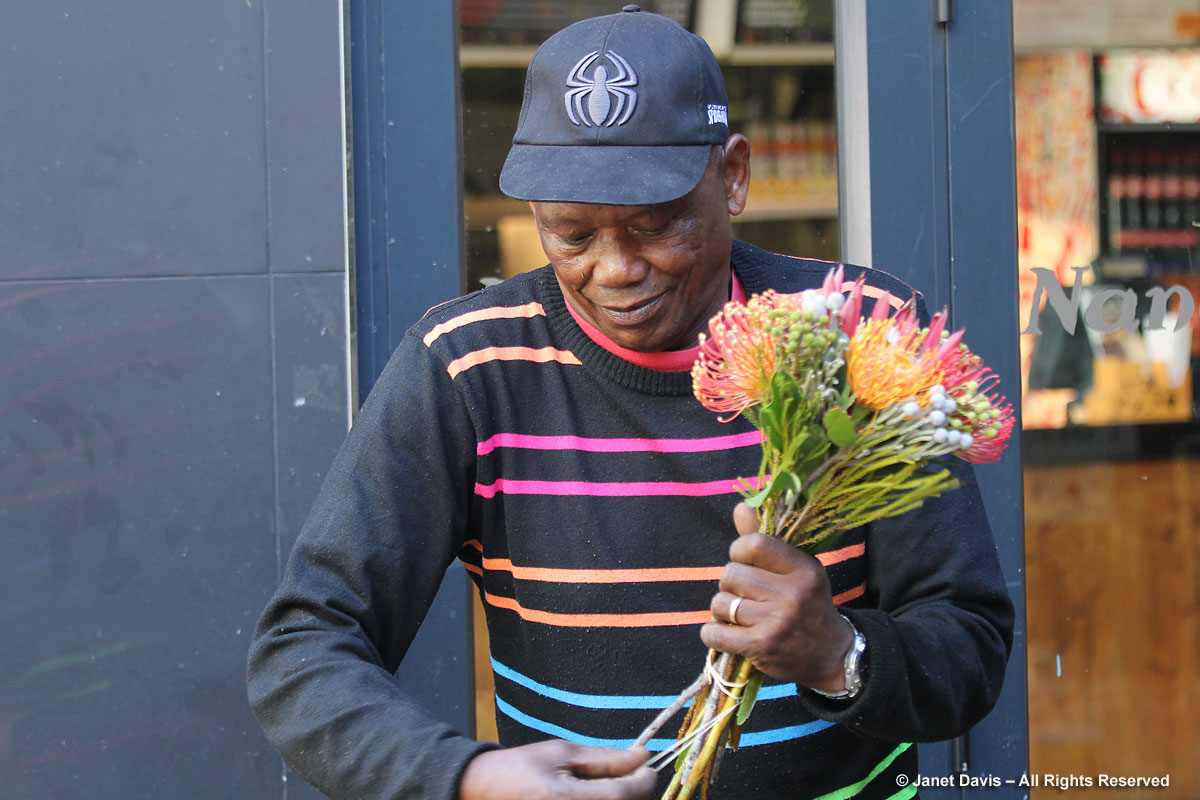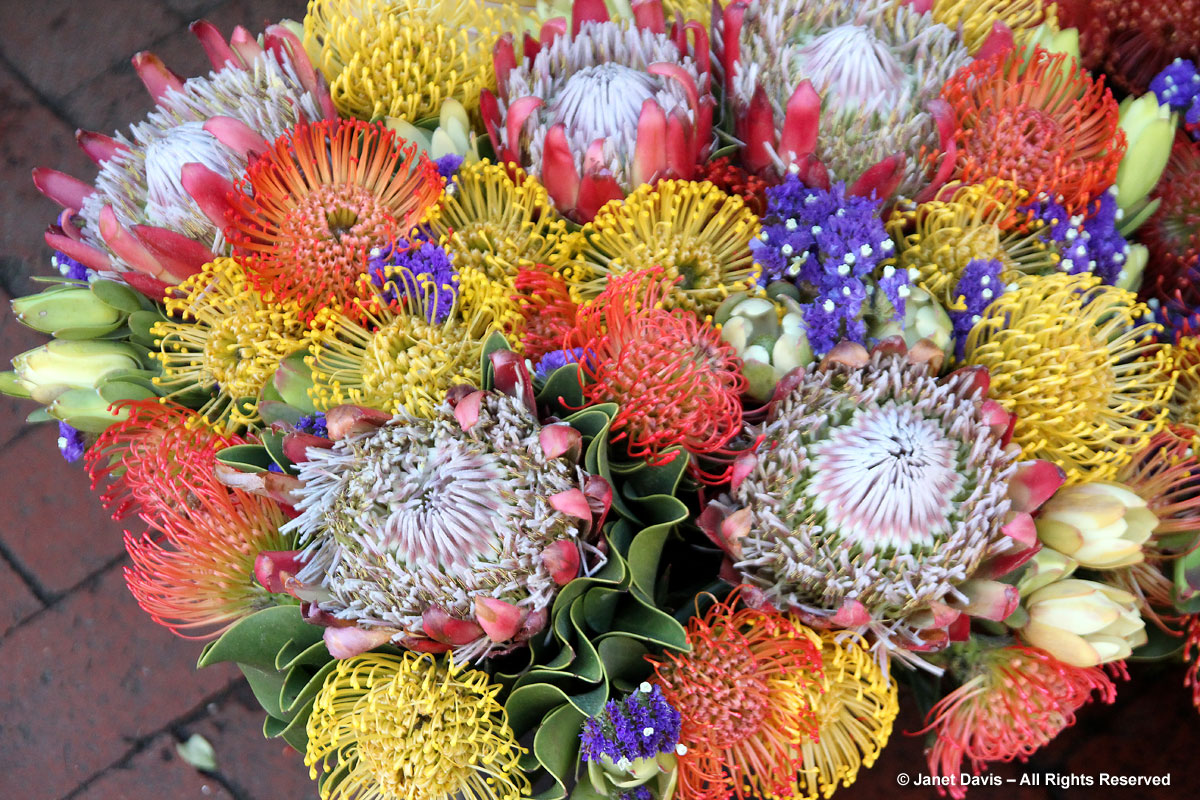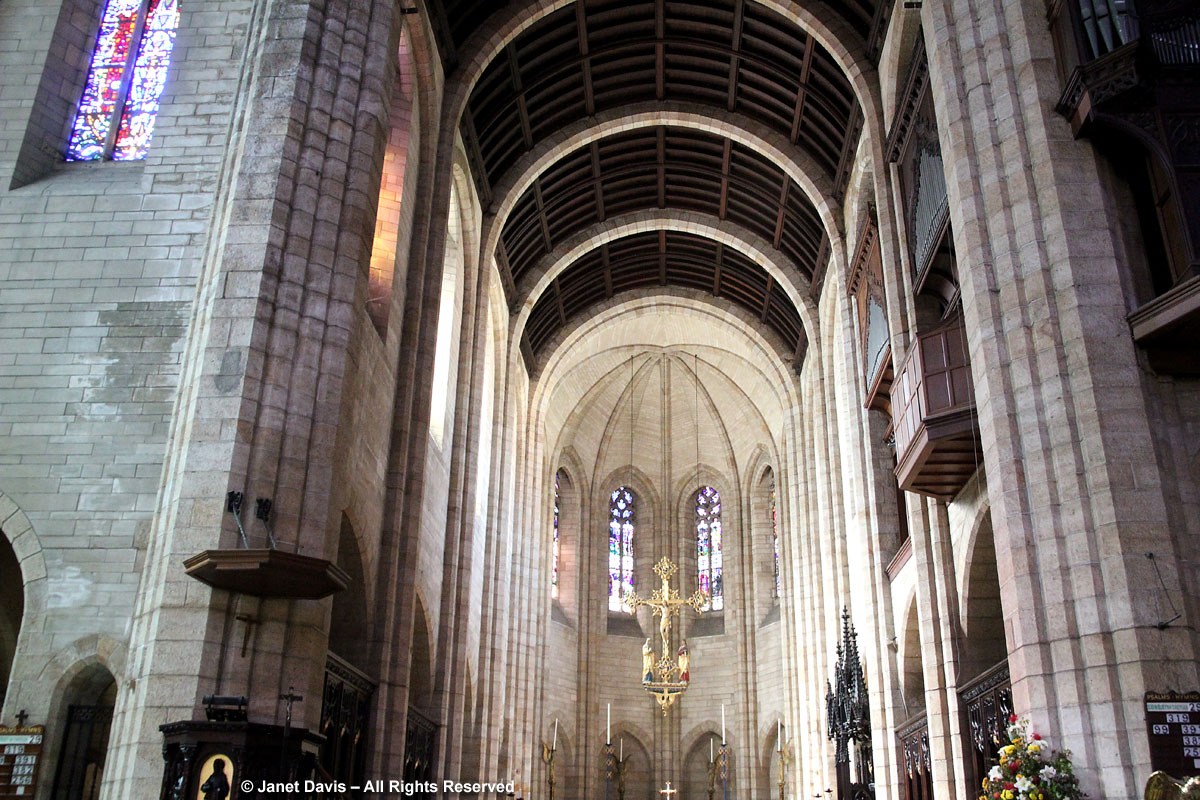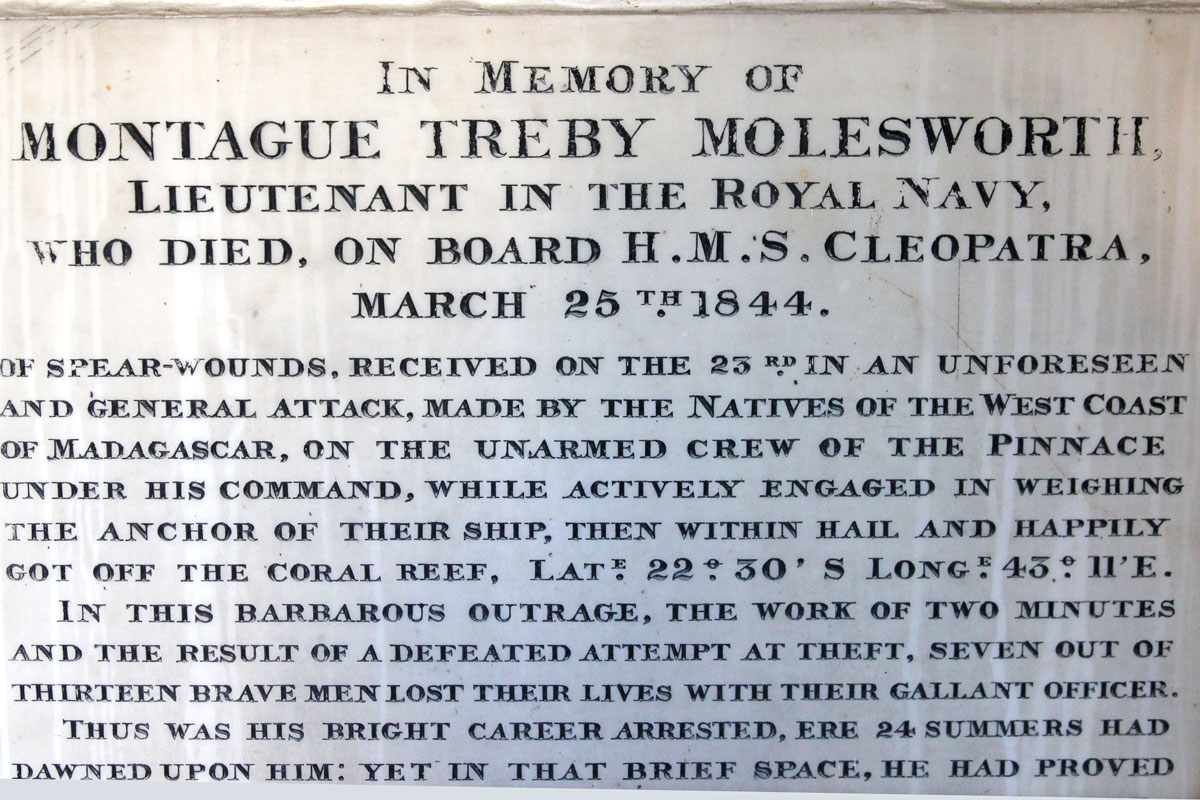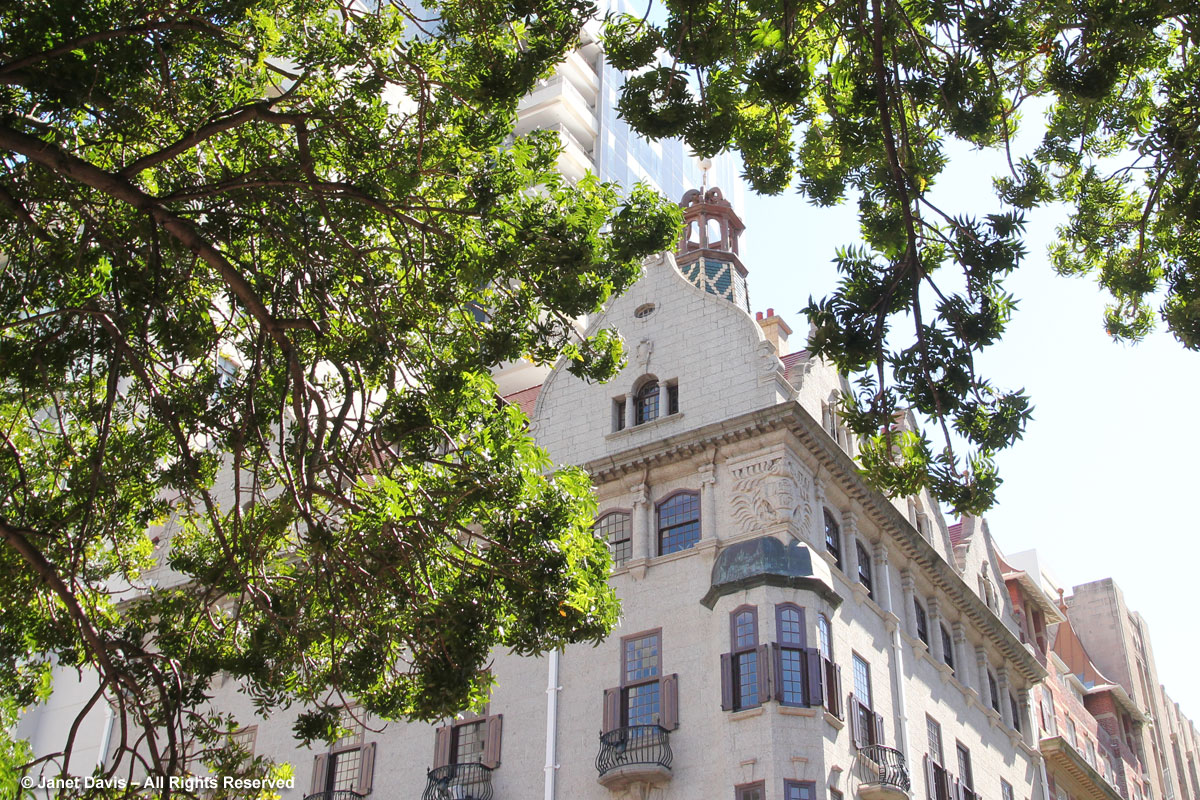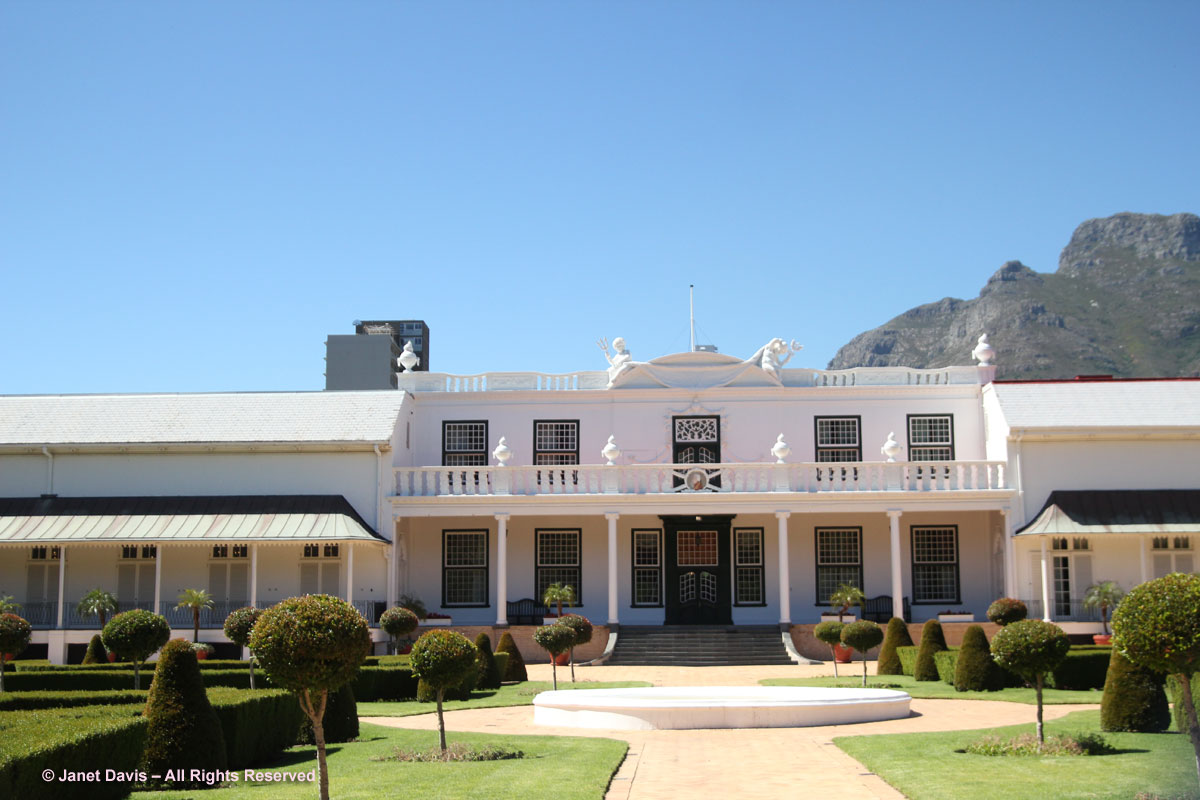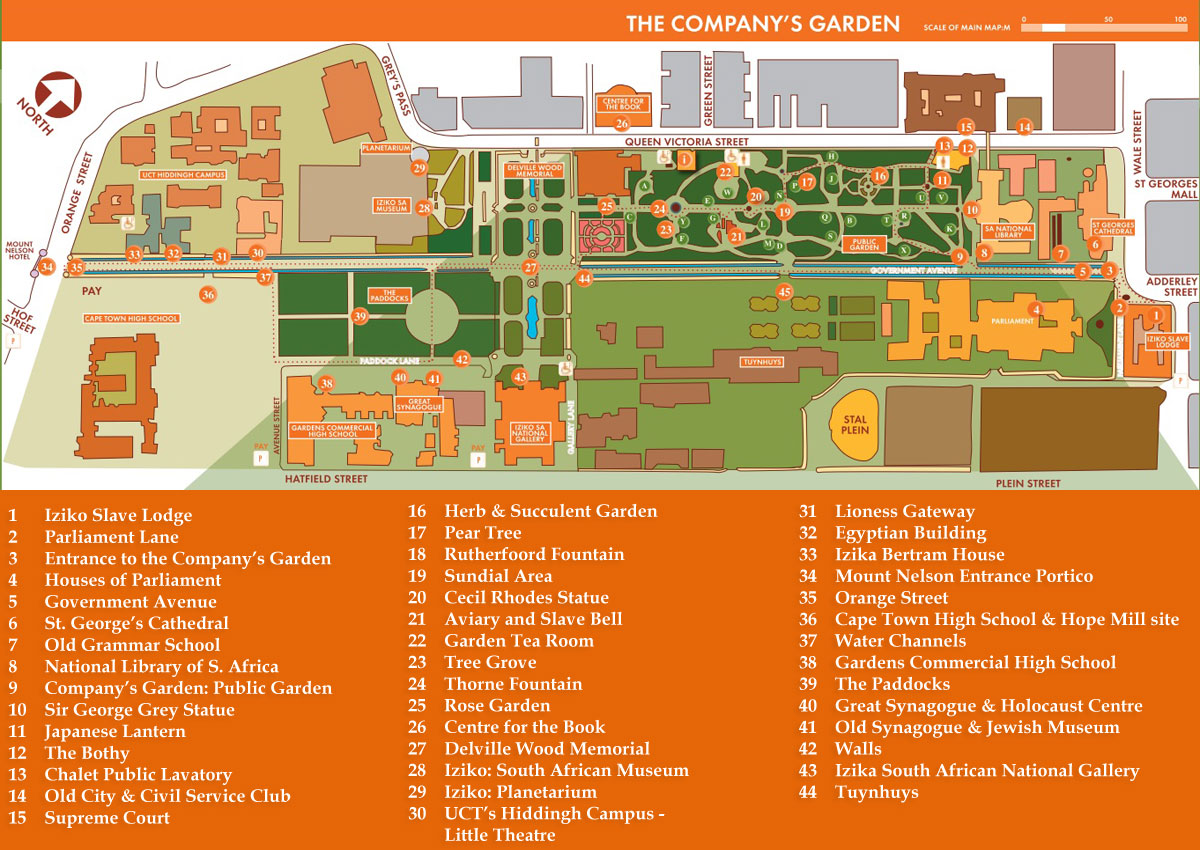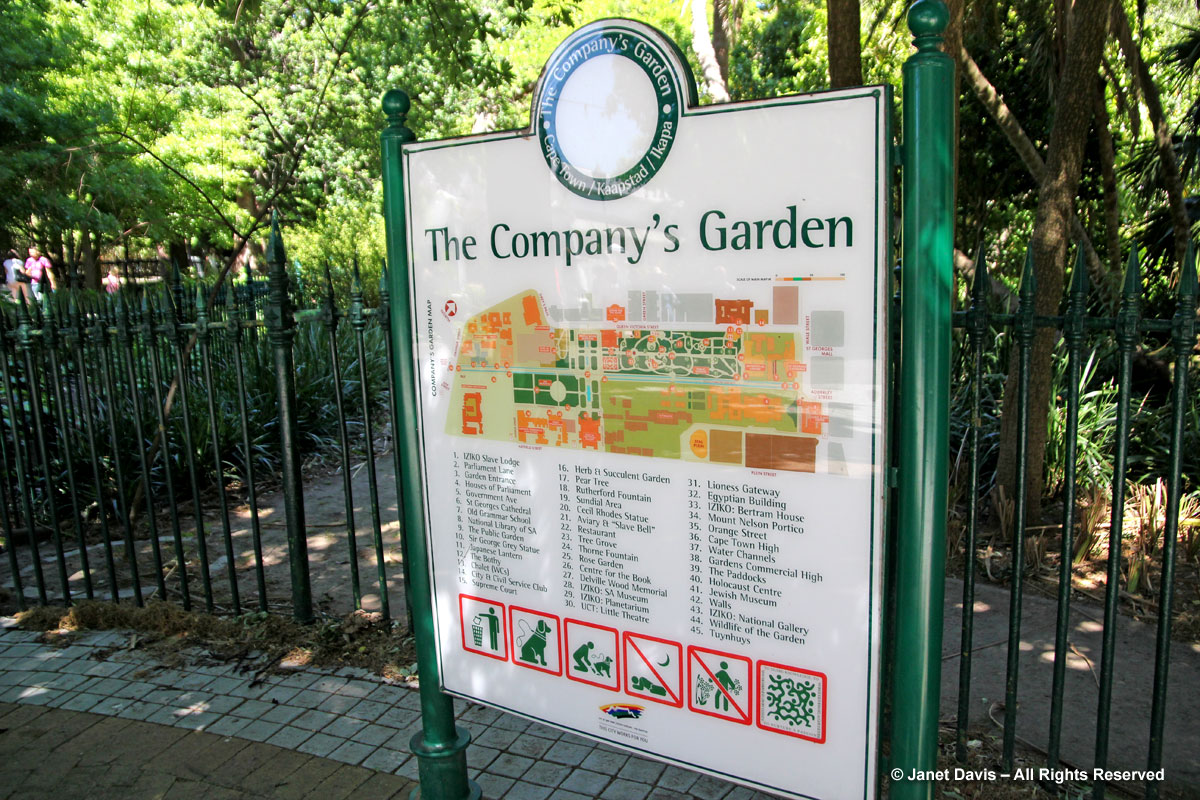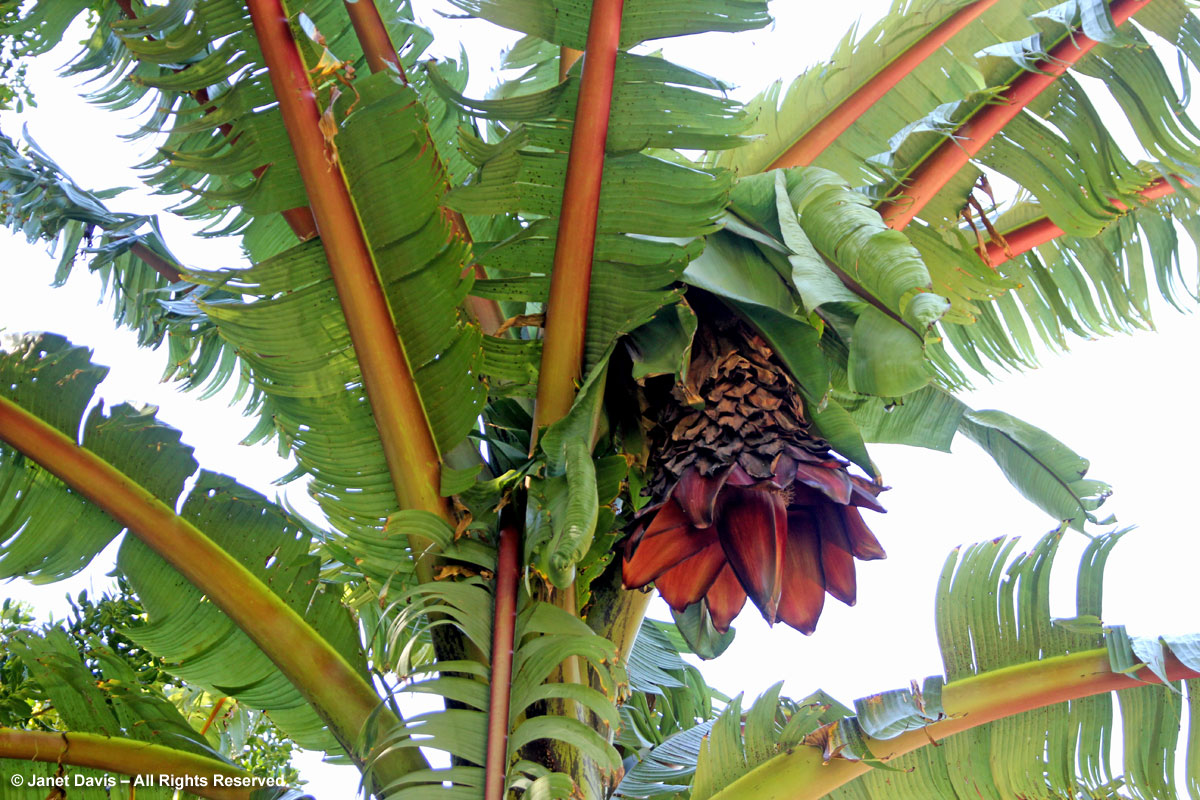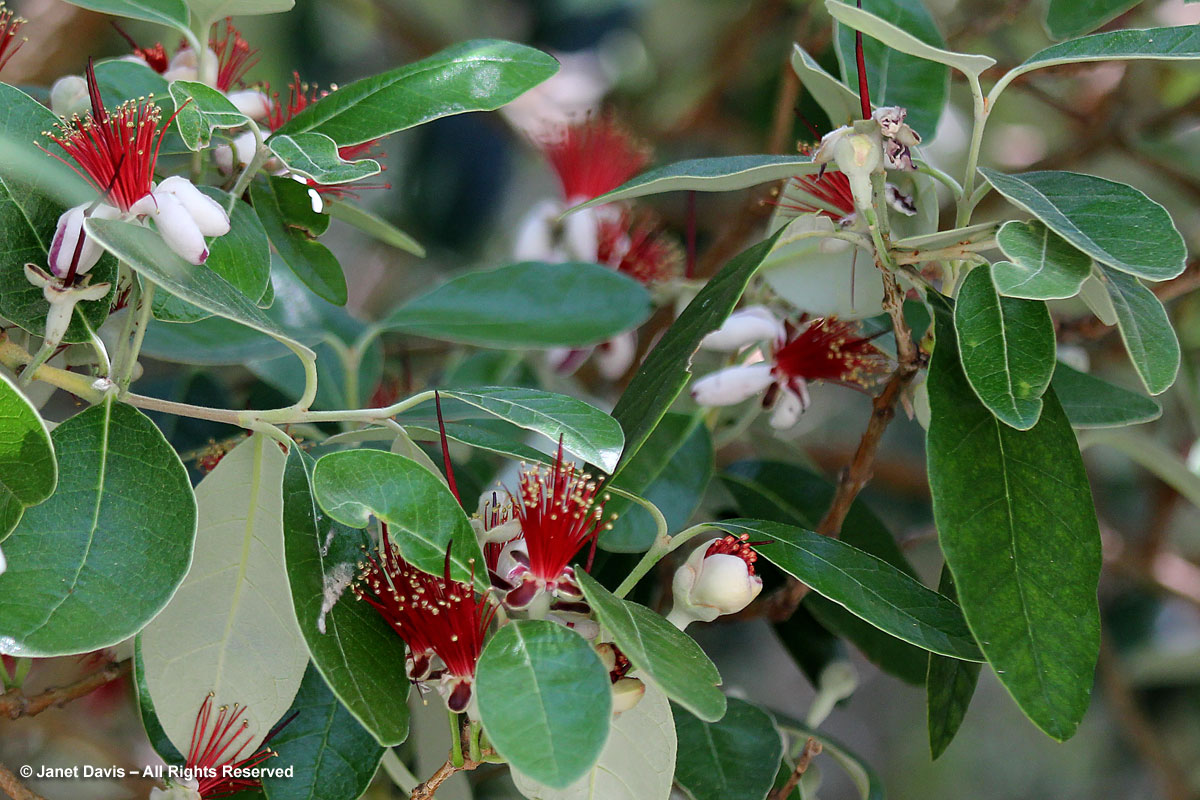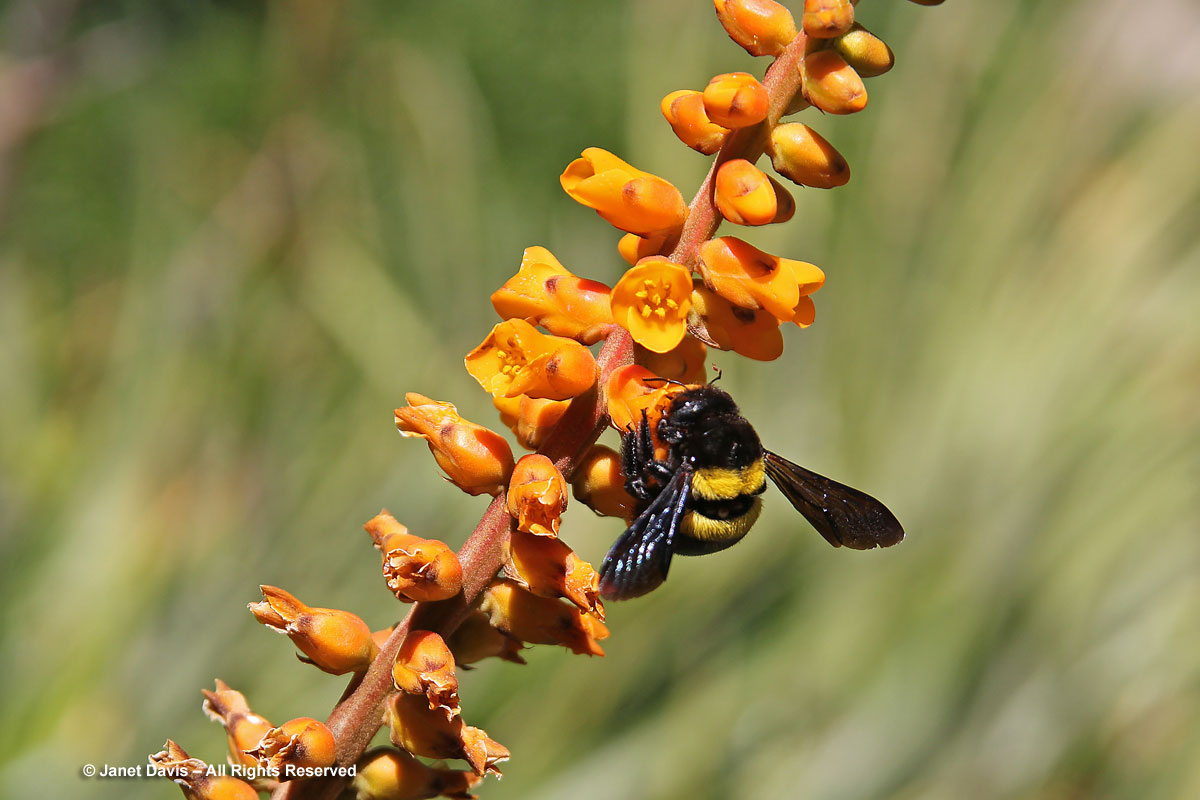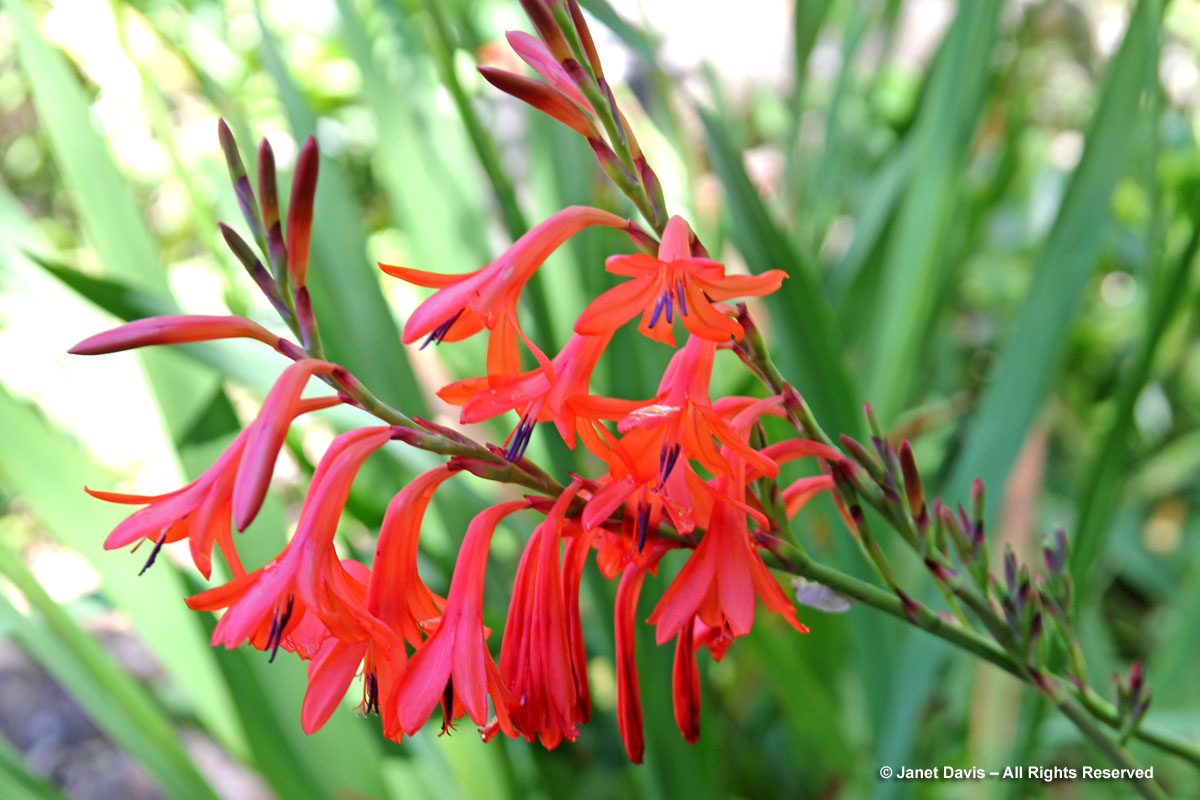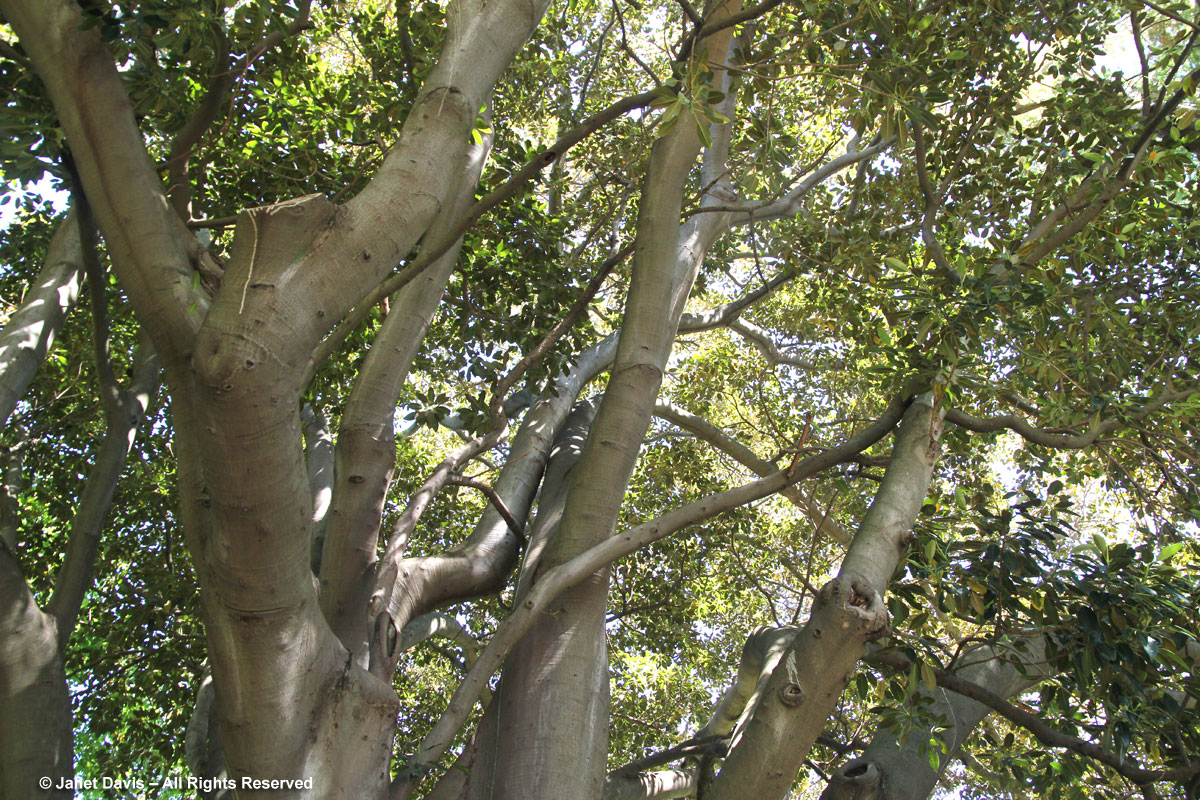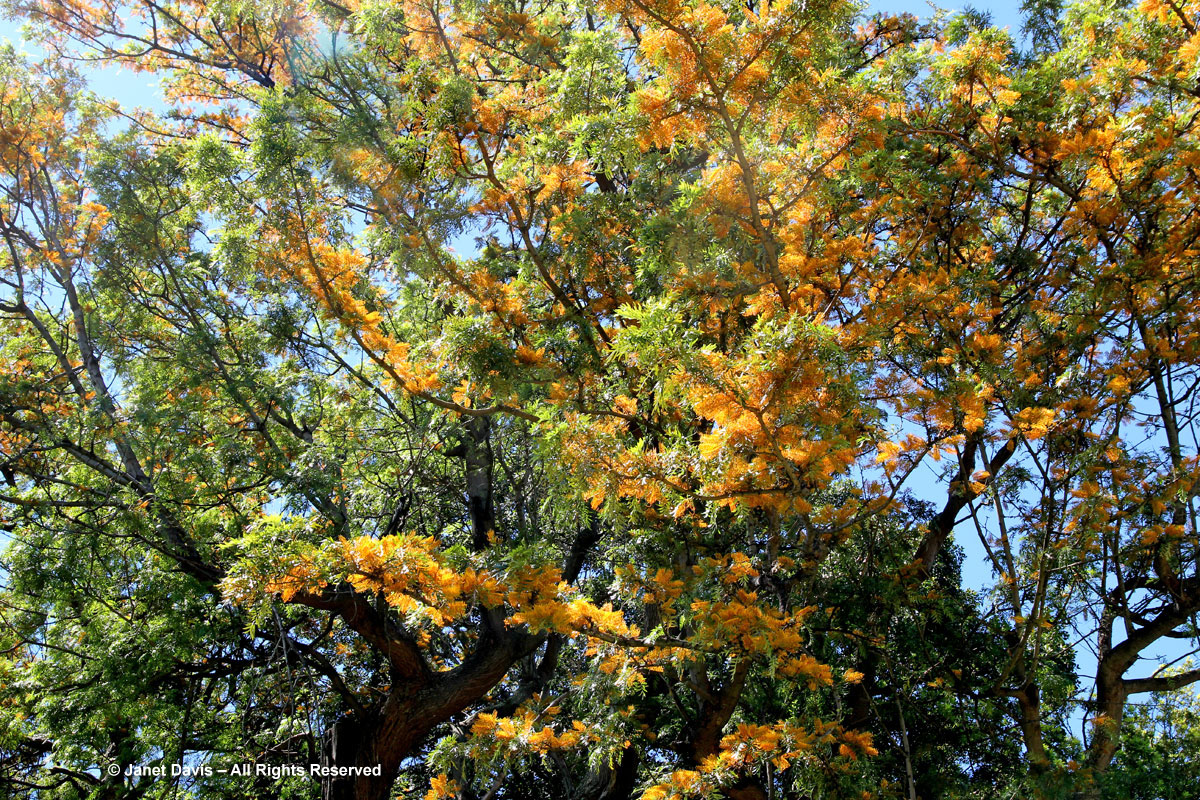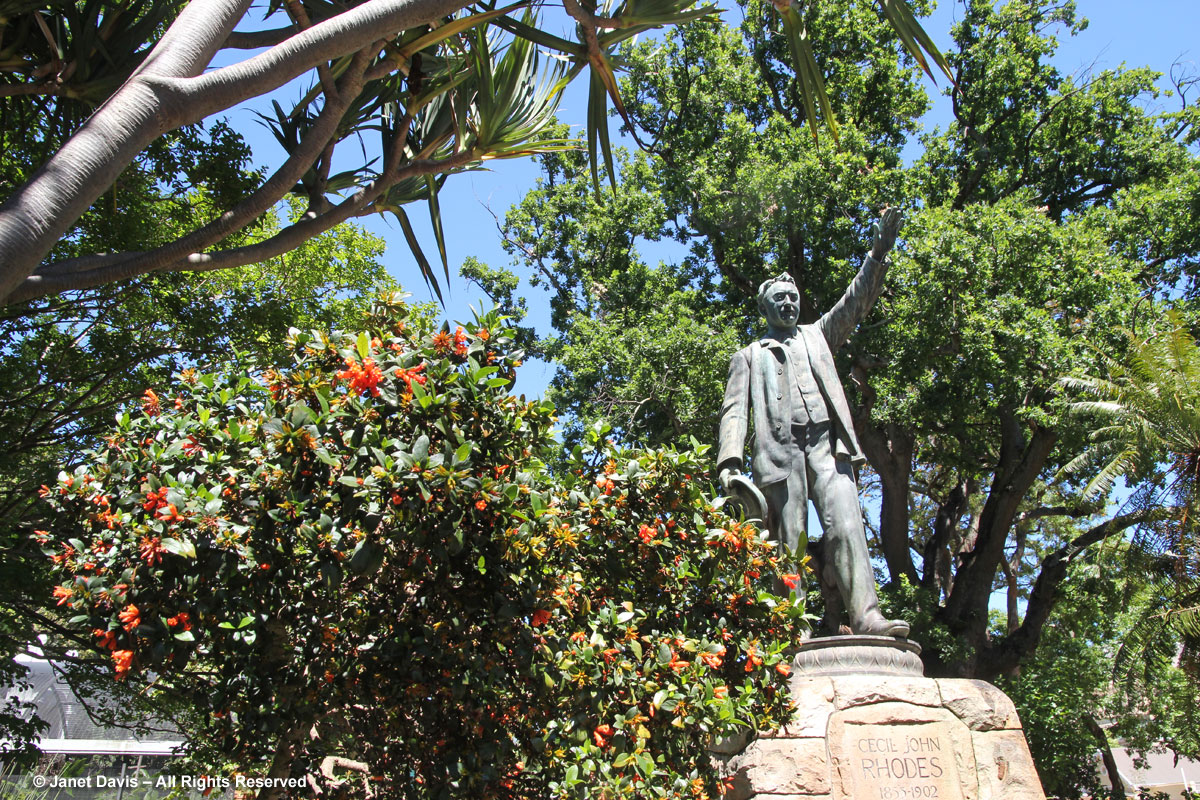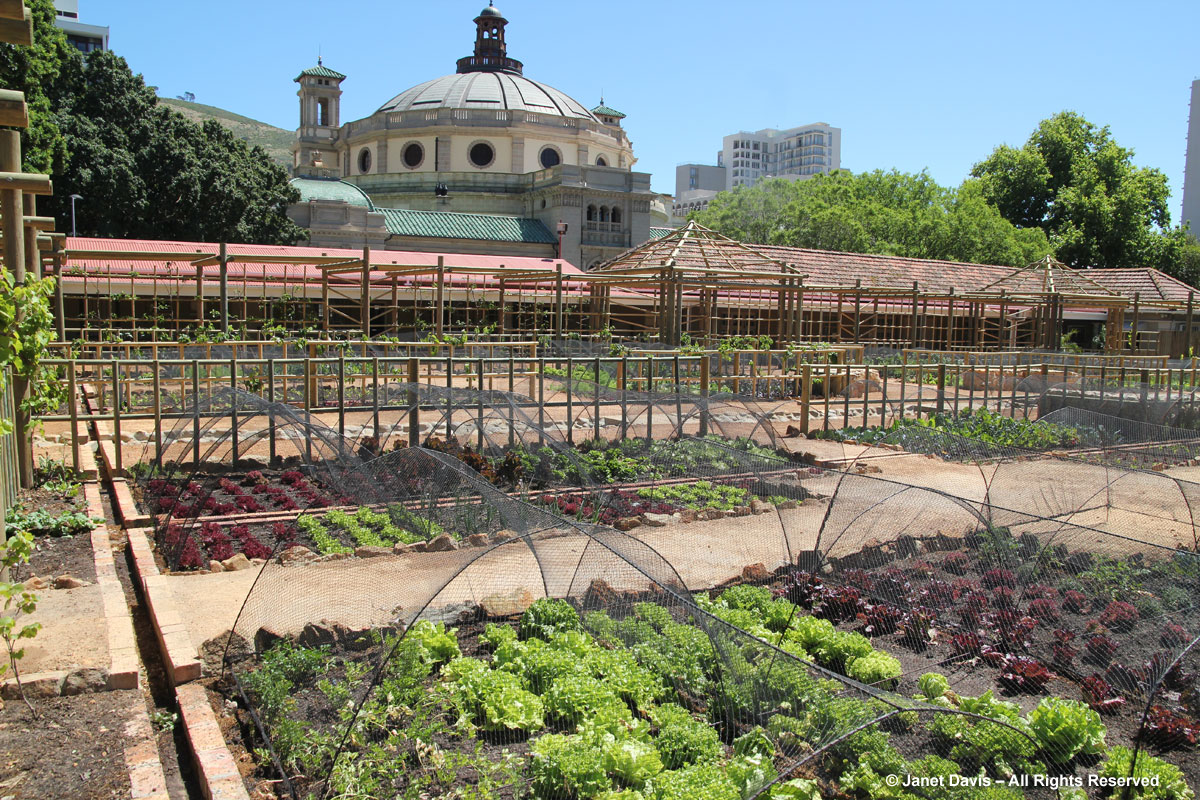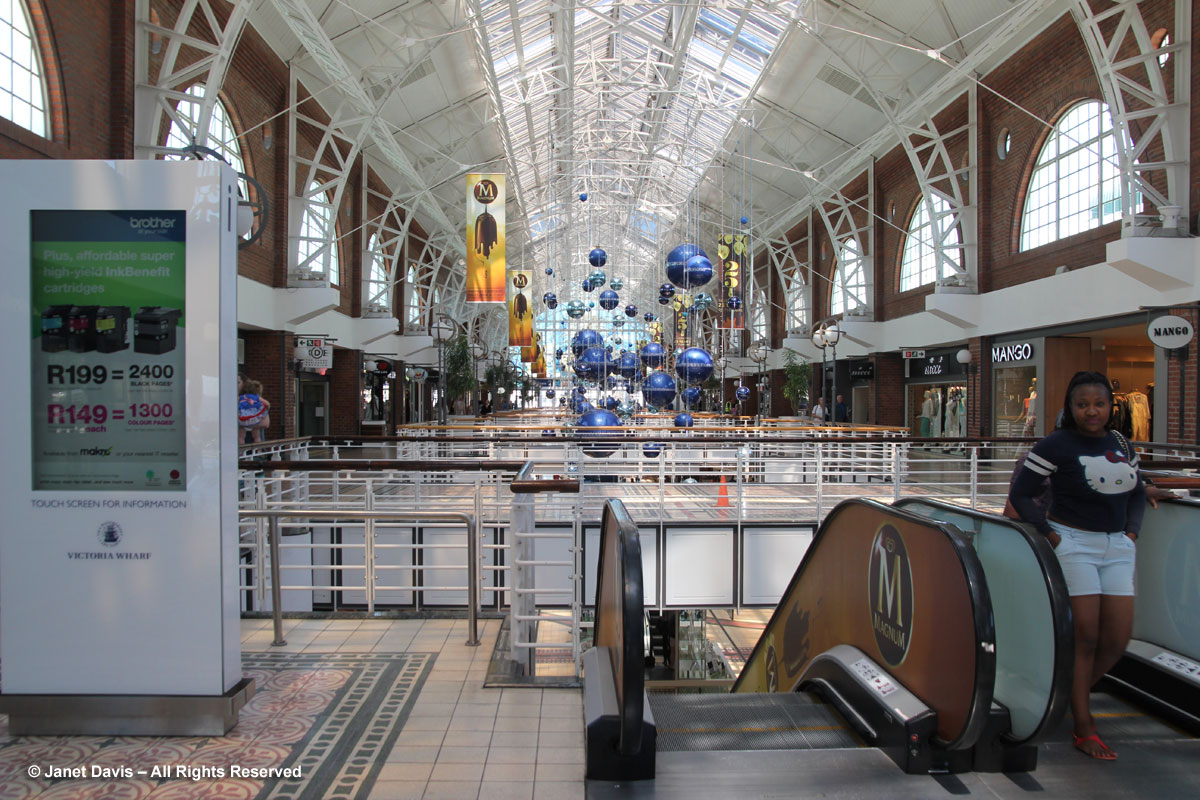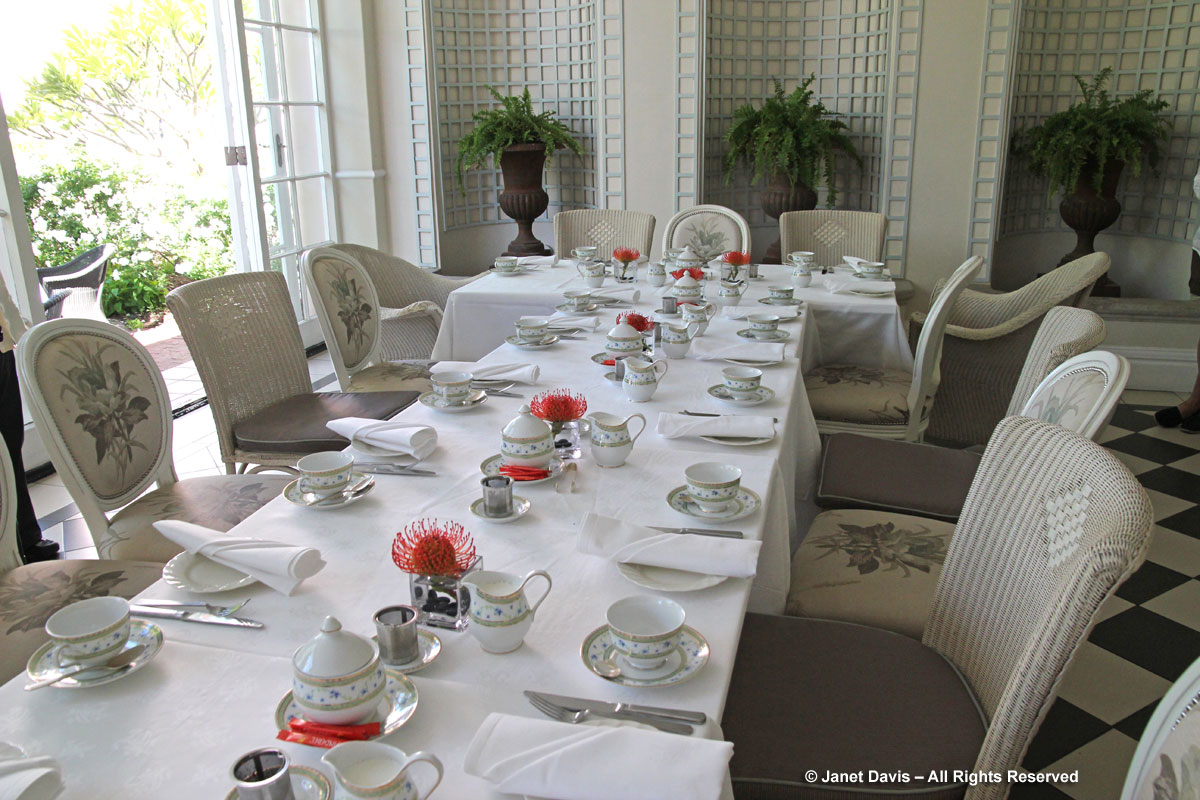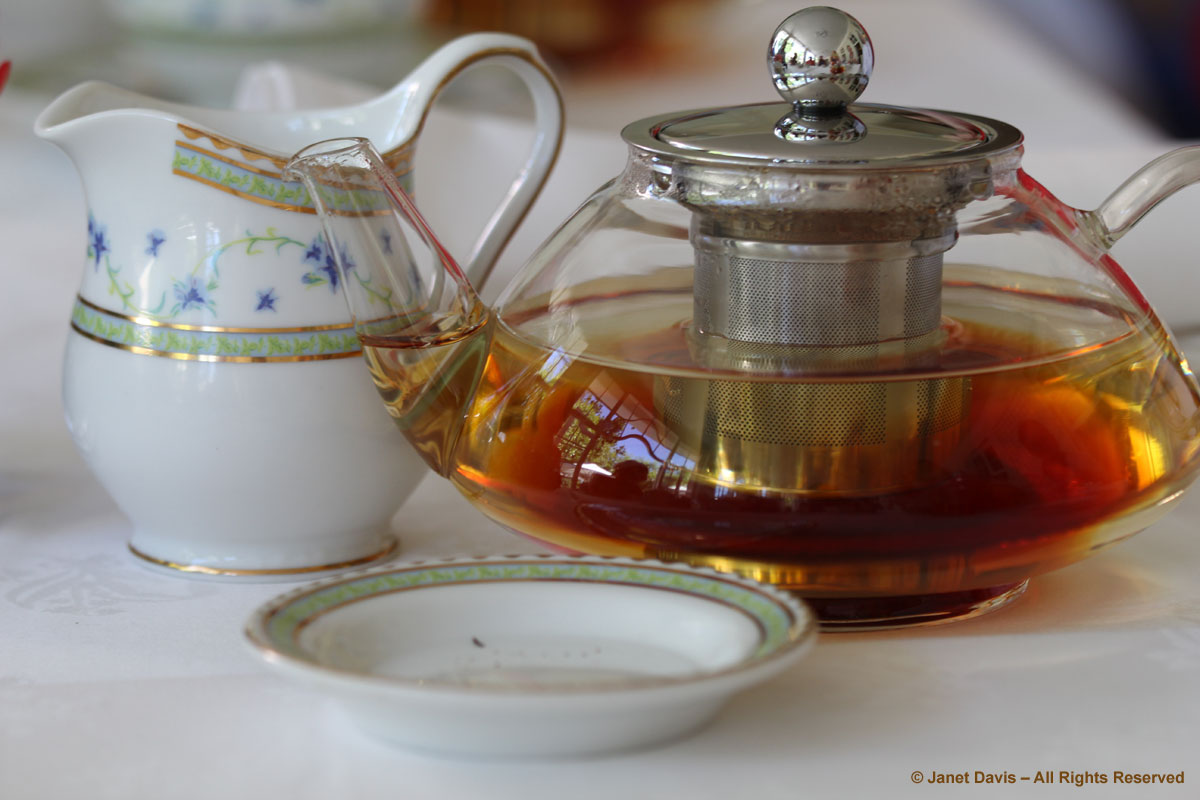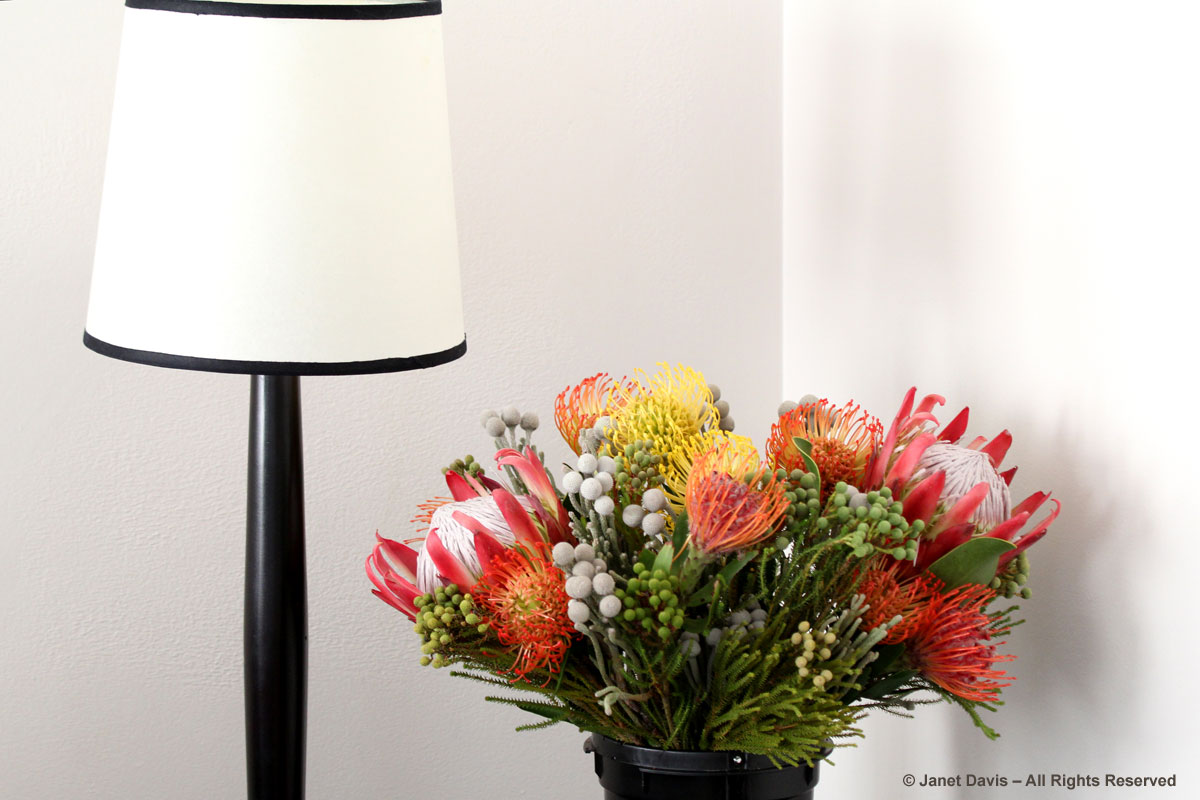Today, the ninth day of our South Africa Garden Tour, we have a very full schedule with plans to visit a number of sites in Cape Town. We begin very close to our hotel, at the Biodiversity Showcase Garden in Green Point Urban Park. A legacy project of the 2010 FIFA World Cup, the park is adjacent to the Cape Town Stadium and is designed to beautify the area while raising awareness of the unique indigenous plants of the city and other nearby regions of the Cape Floristic Kingdom Heritage Site (including Table Mountain National Park). The garden contains more than 25,000 plants comprising 300 native species.
It’s fascinating to see the native South African pelargoniums that have clearly contributed so much to our garden hybrids (especially the zonal geraniums), like this very common tree pelargonium Pelargonium cucullatum. Notice Signal Hill and Lion’s Head looming behind – you might remember them from my visit to the top of Table Mountain.
Unlike most pelargoniums I’ve seen in Canada, I notice a lot of bee activity on these native species. Remember those “killer African bees”? Well, this is the Cape honey bee (Apis mellifera capensis) on P. cucullatum, quietly going about its business – and look at that gorgeous magenta pollen load in its corbicula, or pollen basket!
I love these wetlands at the garden, developed from historic springs in Oranjezicht, a Cape Town suburb on the slopes of Table Mountain.
Cape Town was once called Camissa, meaning “place of sweet waters”, by the aboriginal Khoikoi people and there is a cultural movement to bring the public’s attention back to the water that once gave life to the city before it was diverted to drains and channels.
And this water-wheel fulfills an educational role, teaching about renewable energy while actually producing power.
This interpretive sign offers suggestions on good plants for Lowland Fynbos – areas with sandy, acidic soil and flat terrain, such as used to exist in the Cape Town Flats and Fishoek, but have been lost to development. Recommended plants on the sign are Protea scolymocephala, Serruria aemula, Erica verticillata. The shrubby, yellow button flowers at the base are bitterbush or “bitterbos” in Afrikaans, Chrysocoma ciliata.
Here is the endemic Peninsula travelling aloe (A. commixta), with its unusual prostrate habit.
Soon it’s time to head downtown to continue our city tour. Unlike most of South Africa, which experiences a subtropical climate, Cape Town has a Mediterranean climate, with mild, wet winters (North American summer months) and warm, dry summers (December to March). So palm trees are common on Cape Town boulevards.
Here is the old Cape Town City Hall, built in 1905 using imported English sandstone. On February 11, 1990, just hours after his release from prison, Nelson Mandela made his first public speech from its balcony. Though it’s no longer used for city business it is a frequent venue for cultural events.
We stop briefly outside Cape Town’s oldest surviving building, the Castle of Good Hope. Built by The Dutch East India Company in the late 1660s, it is South Africa’s oldest colonial structure. There was actually an older building on this site originally, built in 1654 by Dutch settlers who established the “victualling” or replenishing station for the Dutch ships sailing the spice route from Holland to the Dutch East Indies (now Indonesia).
Now it’s time for a fun stop at Cape Town’s Adderley Street Flower Market. It’s here where we glimpse for the first time the great diversity of the unique fynbos plants – the leucospermums and proteas and berzelias, etc.(including a few that look suspiciously dyed.)
There are also more traditional flowers, such as roses, lilies and chrysanthemums. The changing tastes of the flower-buying public through the years is one of the interesting back stories of this market (see the flower market history link below).
These flowers, indigenous calla lilies, airy Ammi majus and gold roses, are bound for a wedding, we’re told.
We don’t have much time to talk to the vendors, many of whom are South African “coloured” (meaning people of mixed race) and descendants of slaves. A few vendors, like this man, have worked hard to harvest and maintain interest in the indigenous fynbos flora over exotics.
There is a long and interesting history here, much of it caught up in South Africa’s apartheid past. These stalls are often handed down in families, from mother to daughter or father to son. Like many “coloureds”, the stall owners might have been among those living on flower or vegetable farms on Strawberry Lane in Constantia in 1965 when P.W. Botha declared it a “whites only” zone and sent them to live in shanty towns on the Cape Town Flats.
One thing is clear: amongst our group of tourists, we are all interested in the local flora. Aren’t these gorgeous? I could fill the bus with the ones I’d love to buy, but content myself with one big bunch. Then it’s back to touring.
Our next stop is the beautiful St. George’s Anglican Cathedral, built on a corner of the original Dutch East India Company’s Garden. It was here, during the 1986-96 bishopric of Desmond Tutu, Cape Town’s first black archbishop (he was previously Bishop of Lesotho and Johannesburg and had already won the 1984 Nobel Peace Prize), that the South African government’s apartheid policy was decried from the pulpit. It was Archbishop Tutu who coined the phrase “Rainbow Nation” for the ideals fought for by Nelson Mandela and the other anti-apartheid figures, and it was Archbishop Tutu who found the deep well of understanding and forgiveness that gave rise to his post-apartheid Truth and Reconciliation Commission.
After touring the interior, we walk around the cathedral grounds and I stop to read the memorial tablets built into its foundation. They offer a fascinating glimpse into the historic perils of navy life, both in terms of skirmishes……
…..and the hazards of navigating Cape Town’s once-treacherous Table Bay.
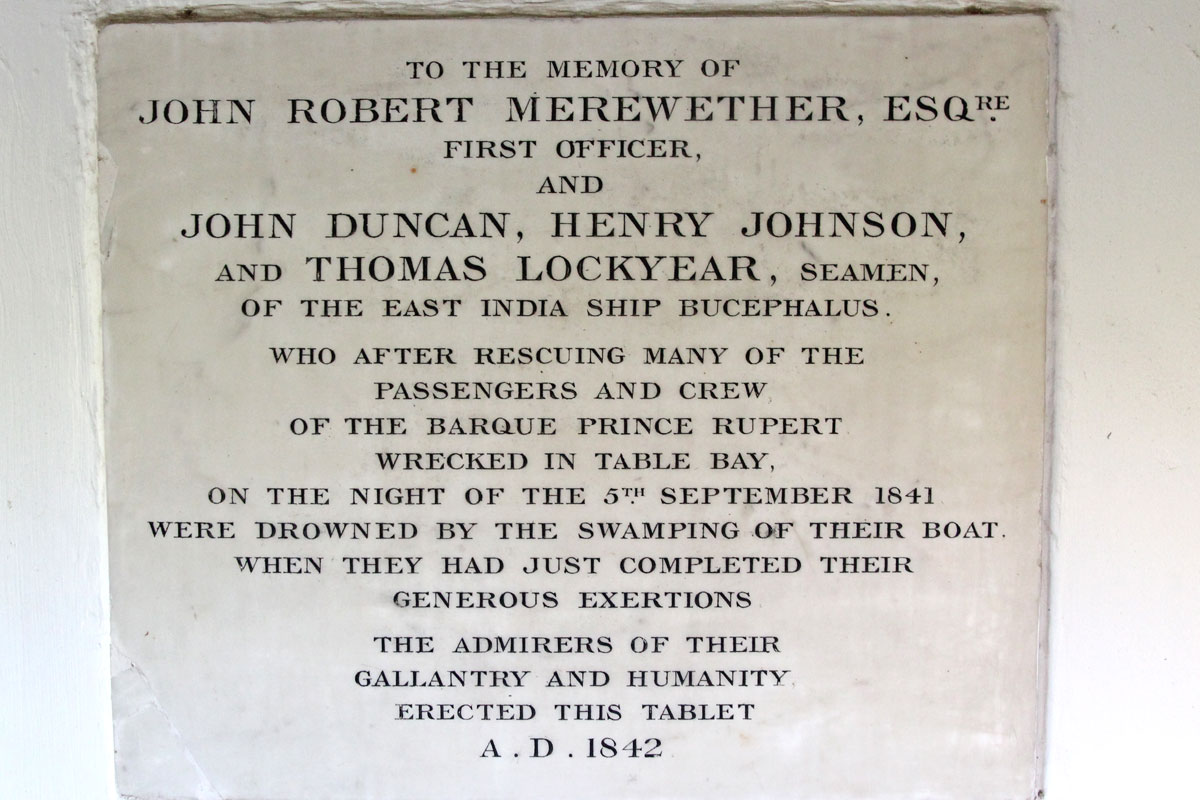
From the cathedral, we can see the beautiful Mandela Rhodes building, once head office of Cecil Rhodes’ De Beers Diamond company, which was founded in 1888 during the diamond rush that ensued upon the 1869 discovery of the 83.5 carat ‘Star of south Africa’ diamond in Hopetown, in the Northern Cape Province. (I’ll write more about Cecil Rhodes in a future blog when we visit his Memorial on Table Mountain.)
The building is now headquarters of the Mandela Rhodes Foundation, which administers funding to African recipients of the Rhodes scholarship to Oxford University in England. This institutional merger of two seemingly conflicting names and philosophies is a fascinating notion, given Rhodes’ views. The following, from the history of the Rhodes Scholarship, shows how fraught with racism were the terms of Cecil Rhodes’ will as it pertained to South Africa.
“South Africa posed a particular problem. Unlike any other jurisdiction to which Scholarships were allocated, South Africa had to select four out of its five Scholars from among the graduates of the four private boys’ secondary schools that had been named in Rhodes’ will. As these schools did not admit black students, the Scholars selected from their ranks were uniformly white, and the fact that South Africa was under apartheid left little doubt that the fifth Scholar selected would be white as well. Not until the 1960s was there any great global criticism of the South African selection process. When there finally was an outcry, the Trustees remonstrated that they lacked the authority to change the terms of Rhodes’ will; this could only be accomplished by amending the original piece of legislation under which his will was administered. Despite the Trustees’ argument that selecting Scholars from these schools defeated the real purpose of Rhodes’ will, the British courts maintained that it was the Trust’s duty to faithfully execute the will as written.
In the 1970s, in an effort to remedy the situation, the Trustees created four new “South-Africa-at-large” Scholarships, to which candidates from anywhere in the country could apply and be considered by a national committee made up of black, as well as white, selectors. Additionally, the Rhodes Trust allocated monies for the creation of the Rhodes Trust Scholarships to fund the university study of promising black candidates and hopefully nurture the development of black Rhodes Scholars. Not until the end of apartheid in 1991, however, was there a significant diversification in South African Scholars registered.”
As we leave the cathedral for The Company’s Garden, we pass groups of lively young Xhosa street dancers. Naturally, I have to make a little film….
https://plus.google.com/106548255417361407356/posts/VwioqL4iAay
In order to visit the Company’s Gardens, we park near the Garden House (De Tuynhuys in Afrikaans), named for the tool house for the garden that first stood on the site in 1674. It was converted to a guesthouse for the Cape Colony’s first Governor Simon Van der Stel (1639-1712), and later became Government House, the residence of the President of South Africa. Following the historic ANC win on April 27, 1994, President Nelson Mandela moved into the Garden House and lived here until retiring from public office in 1999.
The Company’s Garden was created in 1652 originally to grow produce for the Dutch East India Company’s (or, as it was in Dutch, VOC – Vereenigde Oost-Indische Compagnie) ships that loaded supplies here on their way to the Dutch East Indies (Indonesia). In time, it was redesigned in Victorian style and proclaimed for public use in 1848. The gardens occupy a large swathe of the historic centre of Cape Town; their proximity to major cultural institutions and heritage sites (the garden is just under Victoria Street) can be seen on this map which I’ve edited a little in order to present it in one piece. But you can also see it in its original form online.
We walk through the gate. Sadly, the morning sun is blazing and there isn’t a cloud in the sky. It’s a day most visitors love, but for photographers it means forgetting about photos in the sun-dappled garden, since the shadows are just too deep.
Nevertheless, I find some individual vignettes in shade, like this Ethiopian banana (Ensete ventricosum)……..
….and this pineapple guava (Feijoa sellowiana)….
There is an interesting little succulent garden and I’m impressed by the size of the carpenter bees (Xylocopa sp.) nectaring on this orange-flowered dyckia.
A display of indigenous plants includes this gorgeous watsonia.
And there are majestric trees overhead, like this old rubber tree (Ficus elastica).
There are even trees that were once considered beautiful exotics but in our ecologically-minded times are now just considered invasive troublemakers, like this silky oak (Grevillea robusta) from Australia.
And once again, Cecil Rhodes occupies a place of prominence,waving happily behind a pretty wild pomegranate (Burchellia bubalina).
The brand-new VOC Vegetable Garden (summer 2014) was designed in a quadripartite pattern that evokes the Dutch Baroque style of the 17th century. It’s comprised of heirloom fruit, herbs and vegetables in food and water-wise demonstration gardens. Apart from the Dutch colonial history, the garden will feature the food narrative of the Khoikoi who herded animals in the area, as well as the story of slavery and the slave labour that made the original Company’s Garden productive.
We leave the garden and head to the Victoria & Albert Mall for a lunch on our own and lots of time to shop.
Then it’s on to high tea at the elegant Belmond Mount Nelson Hotel….
…where I eschew the South African rooibos (“redbush” tea made from the leaves of the fynbos shrub Aspalathus linearis) for regular old tea.
Finally, we return to our hotel where I empty the bathroom waste basket to use as a vase for my beautiful bouquet of South African fynbos flowers. I only wish I could take it home with me.
Time to rest up before dinner. Tomorrow we head to a very pretty little botanical garden, then to see the right whales in Hermannus. Later in the week, we’re off to wine country — and I’ll take you along if you want to go!

